ASEVI AGROECOLOGY TRAINING
UNIT 1: INTRODUCTION TO AGROECOLOGY
UNIT 1: INTRODUCTION TO AGROECOLOGY
UNIT 1 COURSE OBJECTIVES.
This unit has core objectives of studying agroecology, reflecting its holistic nature as a science, practice, and social movement. By the end of this unit, the participants should be able to:
- Understand and Apply Ecological Principles to Agriculture: To systematically learn how natural ecosystems function (nutrient cycling, energy flow, biodiversity dynamics, population regulation) and apply this understanding to design and manage agricultural systems that mimic, enhance, and work with ecological processes rather than disrupting them.
- Design and Manage Sustainable and Resilient Farming Systems: To acquire the knowledge and skills needed to create productive agricultural systems that minimize negative environmental impacts (e.g., soil degradation, water pollution, biodiversity loss), conserve natural resources, and enhance resilience to climate change, economic shocks, and other disturbances.
- Enhance Biodiversity and Ecosystem Services: To learn strategies for increasing biodiversity at genetic, species, and landscape levels within and around farms, recognizing that this diversity is fundamental for providing essential ecosystem services like pollination, natural pest control, soil fertility maintenance, water regulation, and climate mitigation.
- Optimize Resource Use Efficiency and Promote Recycling: To study and implement practices that maximize the efficient use of locally available resources (water, nutrients, energy, biomass) and minimize waste and dependence on costly, polluting external inputs by closing nutrient and energy loops (e.g., composting, cover cropping, integrated crop-livestock systems).
- Foster Social Equity, Food Sovereignty, and Just Food Systems: To critically analyze power structures within food systems and learn how agroecology empowers smallholder farmers, Indigenous peoples, women, and youth; promotes fair labor and land rights; supports culturally appropriate food production; and advances food sovereignty – the right of peoples to define their own food and agricultural systems.
- Facilitate Co-Creation and Sharing of Diverse Knowledge Systems: To understand the importance of integrating different forms of knowledge (scientific, traditional, Indigenous, local, practical) through participatory processes involving farmers, researchers, and communities. The objective is to develop context-specific solutions and democratize agricultural knowledge.
- Catalyze the Transformation Towards Sustainable and Equitable Food Systems: To equip students and practitioners with the interdisciplinary understanding (ecological, social, economic, political) necessary to critically analyze conventional industrial agriculture, advocate for supportive policies (responsible governance), engage in social movements, and contribute to the systemic transformation of food systems towards sustainability, resilience, and justice at local, regional, and global levels.
Lesson 1 – DEFINITION OF AGROECOLOGY.
Agroecology is an integrative approach that applies ecological principles to agricultural systems, emphasizing sustainability, biodiversity, and resilience. It encompasses scientific research, farming practices, and socio-political movements aimed at transforming food systems to be ecologically sound and socially equitable. This implies that agroecology is farming that centers on food production that makes the best use of nature’s goods and services while not damaging these resources.
Scientific concepts in agroecology:
- Biodiversity: Enhances ecosystem resilience through polycultures, crop rotation, and agroforestry, fostering interactions between species.
- Nutrient Cycling: Mimics natural cycles using compost, green manure, and livestock integration to maintain soil fertility without synthetic inputs.
- Energy Efficiency: Reduces reliance on fossil fuels by optimizing natural processes (e.g., biological pest control, solar energy capture).
- Ecosystem Services: Promotes pollination, water filtration, and carbon sequestration through practices like cover cropping and reduced tillage.
Farming Practices in agroecology include:
- Polycultures & Intercropping: Growing multiple crops together to reduce pests and improve yield stability.
- Agroforestry: Integrating trees with crops/livestock to enhance microclimates and biodiversity.
- Organic Amendments: Using compost, biofertilizers, and biochar to enrich soils.
- Water Management: Techniques like rainwater harvesting and contour farming to conserve water.
- Traditional Knowledge: Reviving indigenous practices (e.g., terraced farming, seed saving) adapted to local conditions.
Socio-Political Dimensions of agroecology include:
- Food Sovereignty: Advocates for community control over food systems, prioritizing local needs over global markets.
- Participatory Approaches: Farmers and researchers co-design practices, ensuring relevance and accessibility.
- Equity & Justice: Addresses land rights, fair labor practices, and gender inclusion, challenging industrial agriculture’s exploitative models.
The challenges in promoting and entrenching agroecology are:
- Scaling Up: Context-specific methods require tailored solutions, complicating large-scale adoption.
- Policy Barriers: Governments often subsidize conventional agriculture, disadvantaging agroecological transitions.
- Knowledge Intensity: Requires training and education, which may be scarce in marginalized regions.
- Market Access: Agroecological products may struggle in markets dominated by industrial goods.
Examples & Success Stories of agroecology are:
- Push-Pull Pest Management (Africa): Intercropping maize with Desmodium (repels pests) and napier grass (attracts predators), boosting yields sustainably.
- Cuba’s Agricultural Shift: Post-Soviet collapse, Cuba transitioned to agroecology, reducing chemical use while maintaining food security.
- La Via Campesina: A global peasant movement advocating agroecology as a tool for social and environmental justice.
Distinctions and Recognition:
- Agroecology differs from organic farming by holistically integrating ecological, economic, and social dimensions.
- Agroecology is recognized by the FAO and IPCC as critical for climate resilience, reducing emissions, and enhancing food security.
Conclusion:
Agroecology offers a transformative pathway toward sustainable food systems by harmonizing ecological health with human well-being. Its success hinges on supportive policies, education, and grassroots mobilization, positioning it as a viable alternative to industrial agriculture in addressing global challenges like climate change and inequality.
REFLECTION ACTIVITY
Here are five thought-provoking questions to assess understanding and encourage deeper reflection on agroecology, based on the detailed explanation provided:
- Define agroecology and explain how it differs from conventional industrial agriculture in its approach to food production.
- How does agroecology challenge the reliance on external inputs (e.g., synthetic fertilizers, pesticides) in conventional agriculture, and what ecological mechanisms does it use to replace them?
(Tests understanding of nutrient cycling, biodiversity, and ecosystem services as alternatives to industrial inputs.) - Why are socio-political dimensions like food sovereignty and equity considered inseparable from agroecological practices? Provide examples of how these principles manifest in real-world systems.
(Evaluates grasp of the intersection between ecology, social justice, and grassroots movements.) - Agroforestry and polycultures are key agroecological practices. Explain how these systems enhance resilience to climate change compared to monocropping.
(Assesses ability to link biodiversity, carbon sequestration, and risk mitigation in agroecological design.) - What barriers might smallholder farmers in developing countries face when adopting agroecology, and how could these challenges be addressed at local and policy levels?
(Encourages critical thinking about structural obstacles like market access, knowledge gaps, and policy biases.) - The FAO recognizes agroecology as a pathway to achieving the Sustainable Development Goals (SDGs). Identify three SDGs agroecology directly supports and justify your choices with agroecological principles.
(Promotes synthesis of agroecology’s role in addressing global challenges like poverty, hunger, and climate action.)
UNIT 1: INTRODUCTION TO AGROECOLOGY
Lesson 2 – EMERGENCE OF AGROECOLOGY AND ITS ROLE IN ADDRESSING THE CHALLENGES FACED BY FOOD SYSTEMS GLOBALLY AND IN AFRICA.
Introduction
The global food system is at a crossroads. Industrial agriculture, driven by synthetic inputs, monocultures, and profit-centric models, has degraded ecosystems, exacerbated climate change, and deepened social inequities. In response, agroecology has emerged as a transformative paradigm rooted in ecological principles, traditional knowledge, and social justice. This essay traces the historical development of agroecology, explores its role in addressing systemic food system challenges globally, and examines its unique potential to revitalize African agriculture.
THE EMERGENCE OF AGROECOLOGY
- Historical Roots
Agroecology’s origins lie in Indigenous and peasant farming systems that prioritized biodiversity, resilience, and symbiosis with nature. For millennia, communities practiced crop rotation, agroforestry, and polycultures, sustaining yields without external inputs. However, the 20th – century Green Revolution sidelined these practices, promoting high-yield monocultures reliant on chemical fertilizers and pesticides. - Scientific and Political Awakening
- 1970s–1980s: Ecologists began framing agriculture as an ecosystem, with pioneers like Miguel Altieri emphasizing biodiversity’s role in pest control and soil health.
- 1990s–2000s: Agroecology expanded beyond science to embrace social movements, critiquing industrial agriculture’s environmental and social harms. La Via Campesina, a global peasant movement, championed agroecology as a tool for food sovereignty.
- 2010s–Present: Institutions like the FAO and IPCC now recognize agroecology as critical to climate resilience and sustainable development.
- Defining Features
Agroecology integrates:
- Ecological principles (e.g., nutrient cycling, biodiversity).
- Social equity (land rights, gender inclusion).
- Participatory knowledge systems (blending science with traditional wisdom).
- GLOBAL FOOD SYSTEM CHALLENGES AND AGROECOLOGICAL SOLUTIONS
- Climate Change
- Problem: Industrial agriculture contributes 25 – 30% of global greenhouse gas emissions through deforestation, methane from livestock, and synthetic fertilizers.
- Agroecological Response:
- Carbon Sequestration: Agroforestry and cover crops store carbon in soils and biomass.
- Resilience: Diverse cropping systems buffer against droughts and floods. For example, drought-tolerant millet-sorghum intercrops in India yield 20 – 30% more than monocultures during dry spells.
- Biodiversity Loss
- Problem: Monocultures and pesticides have caused a 75% decline in insect biomass and eroded crop genetic diversity.
- Agroecological Response:
- Polycultures: Mexican maize-bean-squash systems (milpa) host 50+ species, enhancing pest resistance.
- Habitat Restoration: Hedgerows and pollinator-friendly plants revive biodiversity.
- Soil Degradation
- Problem: Over 33% of global soils are degraded due to erosion and chemical overuse.
- Agroecological Response:
- Organic Amendments: Compost and biochar restore soil organic matter.
- Reduced Tillage: Mimics natural soil structure, preventing erosion.
- Socio-Economic Inequities
- Problem: Corporate consolidation displaces smallholders, while 690 million people face hunger.
- Agroecological Response:
- Food Sovereignty: Communities reclaim control over seeds and land. Brazil’s Landless Workers’ Movement (MST) uses agroecology to resettle 350,000 families on redistributed land.
- Fair Markets: Direct farmer-consumer networks bypass exploitative middlemen.
III. AGROECOLOGY IN AFRICA: A BEACON OF HOPE
Africa faces intersecting crises: climate vulnerability, soil depletion, and chronic food insecurity. Agroecology offers context-specific solutions aligned with the continent’s ecological and cultural diversity.
- Case Studies
- Push-Pull Technology (East Africa):
- Method: Intercropping maize with desmodium (repels stem-borers) and napier grass (lures pests away).
- Impact: Yields increased by 60–400% in Kenya, Uganda, and Tanzania, reducing pesticide use by 90%.
- Farmer-Managed Natural Regeneration (FMNR) in Niger:
- Method: Regenerating native trees (e.g., Faidherbia albida) on croplands to fix nitrogen and improve microclimates.
- Impact: 5 million hectares restored, boosting millet yields by 50–100%.
- System of Rice Intensification (SRI) in Madagascar:
- Method: Reducing water use and transplanting younger seedlings in wider spacing.
- Impact: Yields doubled without synthetic inputs.
- Addressing Structural Barriers
- Policy Support: Malawi’s 2016 National Agroecology Strategy integrates traditional practices into extension services.
- Gender Equity: Women, who constitute 70% of Africa’s smallholders, lead agroecological initiatives like Ghana’s Shea Nut Cooperatives, improving incomes and nutrition.
- Climate Adaptation: Drought-resistant crops (e.g., fonio, teff) and water-harvesting techniques buffer against erratic rainfall.
- Challenges in Scaling
- Corporate Influence: Agribusinesses promote hybrid seeds and glyphosate, undermining agroecological adoption.
- Knowledge Gaps: Limited access to training and peer networks hinders smallholders.
- Land Tenure Insecurity: Without land rights, farmers hesitate to invest in long-term agroecological practices.
- THE PATH FORWARD
- Global Actions
- Policy: Redirect subsidies from industrial agriculture to agroecological research and farmer cooperatives.
- Education: Mainstream agroecology in universities and extension programs.
- Advocacy: Amplify grassroots movements like the Alliance for Food Sovereignty in Africa (AFSA).
- African Innovations
- Digital Tools: Apps like PlantVillage provide pest management advice to Kenyan farmers.
- South-South Collaboration: Benin’s agroecology schools train farmers from across West Africa.
CONCLUSION
Agroecology is not merely a set of practices but a radical reimagining of humanity’s relationship with nature and food. Globally, it counters the extractive logic of industrial agriculture, offering a blueprint for resilience and equity. In Africa, it revitalizes degraded landscapes, empowers marginalized communities, and restores cultural pride in Indigenous knowledge. While challenges remain, agroecology’s holistic ethos—bridging ecology, economy, and ethics – positions it as the most viable pathway to nourishing both people and the planet. As the climate crisis intensifies, embracing agroecology is no longer optional but imperative for a just and sustainable future.
References (for further reading)
- Altieri, M. A. (1995). Agroecology: The Science of Sustainable Agriculture.
- FAO. (2018). The 10 Elements of Agroecology.
- IPES-Food. (2016). From Uniformity to Diversity: A Paradigm Shift.
- African Centre for Biodiversity. (2020). Agroecology Case Studies in Sub-Saharan Africa.
Reflection questions
- What are the key principles of agroecology (as outlined by organizations like FAO), and how do they promote sustainable farming systems?
- How does agroecology address global challenges such as climate change, biodiversity loss, and soil degradation in food systems?
- What unique challenges do African food systems face (e.g., droughts, poverty, land degradation), and how can agroecology provide context-specific solutions?
- Discuss the role of indigenous knowledge and traditional practices in shaping agroecological systems in Africa. Provide examples.
- How can agroecology improve food security and rural livelihoods in Africa while reducing reliance on external inputs like synthetic fertilizers?
- What policy or institutional barriers hinder the adoption of agroecology in Africa, and how might these be overcome?
- Provide examples of successful agroecology initiatives in Africa (e.g., farmer-led cooperatives, agroforestry projects) and their impacts.
- Critically assess the scalability of agroecology in Africa: What economic, social, or infrastructural challenges might limit its widespread adoption?
- How does agroecology enhance climate resilience in farming systems compared to conventional methods, particularly in drought-prone regions of Africa?
UNIT 1: INTRODUCTION TO AGROECOLOGY
Lesson 3: THE TEN INTERLINKED ELEMENTS OF AGROECOLOGY
Introduction
Agroecology, a holistic approach to agriculture, integrates ecological principles, social equity, and economic resilience to transform food systems. Emerging as a response to the environmental and social crises wrought by industrial agriculture, agroecology offers a framework to address global challenges such as climate change, biodiversity loss, and food insecurity. The Food and Agriculture Organization (FAO) identifies ten interlinked elements of agroecology that collectively foster sustainability, resilience, and equity. This lesson explores these elements, their synergies, and their relevance to global and African contexts.
- Diversity
Diversity is the cornerstone of agroecology, encompassing genetic, species, and ecosystem variety. Polycultures, crop rotations, and integrated livestock systems mimic natural ecosystems, reducing pest outbreaks and enhancing nutrient cycling. For example, African farmers practicing intercropping (e.g., maize with legumes like beans) benefit from nitrogen fixation, improved soil health, and diversified yields. Diversity buffers against climate shocks and market volatility, ensuring food security.
Interlinkage: Diversity underpins synergies and resilience, reducing dependence on external inputs.
- Synergies
Synergies arise when agricultural components interact to enhance productivity. Agroforestry systems, where trees shade crops and livestock, improve microclimates and provide fodder. In West Africa, the “Faidherbia albida” tree boosts maize yields by shedding nitrogen-rich leaves during the rainy season. Such synergies optimize resource use, reducing the need for synthetic fertilizers.
Interlinkage: Synergies enhance efficiency and recycling, creating self-sustaining systems.
- Efficiency
Efficiency focuses on optimizing resource use—water, energy, and nutrients—through practices like drip irrigation or precision farming. By minimizing waste, agroecology lowers costs and environmental impacts. For instance, Zai pits in Burkina Faso capture rainwater efficiently, revitalizing degraded soils.
Interlinkage: Efficient systems reduce pressure on ecosystems, supporting resilience.
- Resilience
Resilience refers to the capacity to withstand shocks like droughts or economic crises. Diversified agroecological farms recover faster from climate extremes. In Kenya, drought-tolerant millet and sorghum varieties, paired with soil conservation, help farmers adapt to erratic rainfall.
Interlinkage: Resilience is bolstered by diversity, recycling, and local knowledge.
- Recycling
Recycling organic matter and nutrients closes ecological loops. Composting crop residues or integrating livestock manure into fields reduces reliance on chemical fertilizers. In Rwanda, farmer cooperatives compost banana waste to rejuvenate soils, exemplifying circularity.
Interlinkage: Recycling enhances soil health, driving synergies and efficiency.
- Co-creation and Sharing of Knowledge
Agroecology thrives on blending traditional wisdom with scientific innovation. Farmer-to-farmer networks, like those in Senegal, share pest management techniques using neem extracts. Participatory research ensures solutions are context-specific and culturally relevant.
Interlinkage: Knowledge co-creation strengthens human values and cultural practices.
- Human and Social Values
Equity, gender inclusion, and fair labor practices are central. Agroecology empowers marginalized groups, such as women in Uganda accessing land through community gardens. Social cohesion fosters collective action, critical for scaling practices.
Interlinkage: Social equity reinforces responsible governance and solidarity economies.
- Culture and Food Traditions
Indigenous diets and rituals, like Ethiopia’s enset-based systems, preserve biodiversity and nutrition. Agroecology revitalizes cultural identity, promoting heritage crops like fonio in Mali.
Interlinkage: Cultural practices sustain diversity and knowledge systems.
- Responsible Governance
Policies must prioritize smallholders’ rights and agroecological transitions. Zambia’s agroecology policy supports seed sovereignty, while Benin’s bans on toxic pesticides protect ecosystems.
Interlinkage: Governance enables circular economies and equitable resource access.
- Circular and Solidarity Economy
Localized markets and fair trade, such as Ghana’s organic shea butter cooperatives, reduce waste and empower producers. Circular models prioritize sustainability over extraction.
Interlinkage: Solidarity economies align with recycling and social values.
INTERCONNECTEDNESS OF THE ELEMENTS
These elements are mutually reinforcing. Diversity and synergies enhance efficiency, while recycling and resilience reduce external dependencies. Co-created knowledge upholds cultural traditions, and responsible governance enables equitable economies. In Africa, where droughts and poverty intersect, agroecology’s integrated approach offers climate adaptation, livelihood improvement, and ecosystem restoration.
Case Study: The Tigray Project in Ethiopia combined water harvesting, composting, and agroforestry, doubling yields and reversing desertification through element integration.
Conclusion
The ten elements of agroecology form a cohesive framework for reimagining food systems. By prioritizing ecological balance, social justice, and economic inclusivity, agroecology addresses global crises while honoring local contexts. In Africa, its adoption could unlock sustainable development, proving that resilience and equity are achievable through interconnected, nature-based solutions.
******************************************************************************
QUESTIONS
Here are twelve questions covering the ten interlinked elements of agroecology (as defined by FAO), designed to test understanding and application:
- How does increasing diversity (e.g., crop varieties, livestock breeds, non-productive vegetation) within an agroecosystem contribute to reducing vulnerability to pests, diseases, and climate shocks? Provide one specific example.
- Explain how fostering synergies between different components of a farm (e.g., crops, trees, animals) can enhance overall productivity and resource use efficiency. Give an example like agroforestry or integrated crop-livestock systems.
- The element of efficiency focuses on optimizing resource use. Describe two strategies that improve the efficiency of water or nutrient use in agroecological systems, moving away from heavy external input dependency.
- How do agroecological practices specifically enhance the resilience of farming systems to withstand and recover from disturbances like droughts, floods, or economic shocks? Mention at least two contributing factors.
- Explain the principle of recycling in agroecology. How does closing nutrient loops through practices like composting, manure management, or crop residue incorporation contribute to sustainability and reduce pollution?
- Why is the co-creation and sharing of knowledge (combining traditional, indigenous, practical, and scientific knowledge) considered fundamental to the transition and scaling up of agroecology? What does this process involve?
- Describe a practical scenario where co-creation of knowledge between farmers and researchers might lead to the development of a more effective, locally adapted agroecological practice.
- The element of human and social values emphasizes equity, inclusion, and justice. How can agroecology empower marginalized groups (e.g., smallholder farmers, women, youth) and contribute to improved food sovereignty?
- How do culture and food traditions influence and are preserved through agroecological practices? Why is maintaining this link important beyond just food production?
- What role does responsible governance (at local, national, international levels) play in enabling the transition to agroecology? Give one example of a policy or institutional change that could support agroecological farmers.
- Explain how agroecology promotes a circular and solidarity economy. How do practices like local food webs, Community Supported Agriculture (CSA), or fair trade embody this principle?
- Choose ANY TWO specific elements of agroecology (e.g., Synergies & Recycling; Diversity & Resilience; Human Values & Responsible Governance) and describe how they are interconnected and mutually reinforcing in practice.
UNIT 1: INTRODUCTION TO AGROECOLOGY
Lesson 4: CULTIVATING HARMONY: THE FOUNDATIONAL PRINCIPLES OF AGROECOLOGY
Agroecology transcends the narrow definition of a mere set of agricultural techniques. It represents a transformative paradigm, a science, a practice, and a social movement fundamentally reimagining our relationship with food systems and the natural world. At its core lie a set of interconnected principles that guide the design, management, and evaluation of sustainable and equitable agricultural systems. These principles move beyond the input-output logic of industrial agriculture, embracing complexity, resilience, and the intrinsic value of ecological and social relationships. Understanding these principles is key to unlocking the potential of agroecology to address the intertwined crises of climate change, biodiversity loss, and food insecurity.
While various frameworks articulate agroecology’s principles (e.g., FAO’s 10 Elements, Gliessman’s 5 Levels of Transition, HLPE’s 13 Principles), they converge on common foundational themes. These can be broadly grouped into ecological, socio-economic, and governance dimensions:
- ECOLOGICAL PRINCIPLES: Mimicking Nature’s Wisdom.
- Enhance Biodiversity: This is the cornerstone. Agroecology actively promotes diversity at all levels: genetic (crop varieties, livestock breeds), species (polycultures, cover crops, integrated crops-livestock-trees), and landscape (hedgerows, ponds, natural habitats). Biodiversity underpins ecosystem stability, natural pest regulation, pollination, nutrient cycling, and resilience against shocks like drought or disease. Example: Intercropping maize with legumes like beans fixes nitrogen and suppresses weeds.
- Create Synergies: Agroecology designs systems where different components interact beneficially. Trees provide shade and fodder for livestock, whose manure fertilizes crops; beneficial insects attracted to flowering hedges control crop pests. The whole becomes greater than the sum of its parts, enhancing resource use efficiency and productivity. Example: Agroforestry systems combining fruit trees, shade-tolerant crops, and livestock.
- Boost Efficiency in Resource Use: The focus shifts from maximizing external inputs to optimizing biological processes and recycling. Agroecology aims to use water, nutrients, and energy more efficiently within the system, minimizing waste and dependence on costly, often polluting, external inputs. Example: Precision irrigation, composting farm waste, using legume rotations for nitrogen.
- Increase Resilience: By building biodiversity, soil health, and decentralized knowledge, agroecological systems become more robust and adaptable. They can better withstand and recover from environmental stresses (droughts, floods, pests) and economic fluctuations, ensuring more stable food production and livelihoods. Example: Diverse cropping systems buffer against total crop failure if one species is affected.
- Recycle Nutrients and Energy: Agroecology strives for closed-loop systems. Organic matter (crop residues, manure) is recycled back into the soil as compost. Water is harvested and conserved. Energy flows (like sunlight captured by plants) are maximized, minimizing external energy dependency and pollution. Example: Integrating livestock to consume crop residues and produce manure for fertilization.
- SOCIO-ECONOMIC PRINCIPLES: Centering People and Equity.
- Co-Creation and Sharing of Knowledge: Agroecology values the dynamic interplay between traditional, Indigenous, local farmer knowledge and formal scientific research. Knowledge is not imposed but developed collaboratively through participatory processes, ensuring solutions are context-specific and culturally relevant. Farmer-to-farmer exchanges are vital. Example: Researchers and farmers co-designing pest management strategies based on local observations and ecological science.
- Strengthen Human and Social Values: Equity, dignity, justice, and inclusion are central. Agroecology empowers smallholder farmers, women, youth, and Indigenous communities. It promotes fair labor practices, secure land tenure, and equitable access to resources and markets, fostering vibrant rural communities. Example: Supporting women’s cooperatives producing and marketing agroecological products.
- Protect Culture and Food Traditions: Agroecology respects and revitalizes cultural identities linked to food production and consumption. It supports diverse, nutritious, culturally appropriate diets, strengthening food heritage and local culinary practices often eroded by industrial food systems. Example: Preserving heirloom seed varieties and traditional recipes linked to local festivals.
- Foster Circular and Solidarity Economies: Agroecology promotes local and regional food systems based on fair trade, direct marketing, and community support. It emphasizes economic models that prioritize well-being over pure profit, reduce waste, and build mutual support networks between producers and consumers. Example: Community Supported Agriculture (CSA) schemes, local farmers’ markets, fair-trade cooperatives.
- GOVERNANCE PRINCIPLES: Enabling Systemic Change.
- Ensure Responsible Governance: Transitioning to agroecology requires supportive policies and institutions at all levels. This includes redirecting subsidies towards sustainable practices, regulating harmful inputs, ensuring land rights, prioritizing agroecology in research funding, and developing markets for agroecological products. Governance must be transparent, inclusive, and accountable. Example: National policies banning highly hazardous pesticides and promoting agroecological extension services.
The Power of Interlinkage:
The true strength of agroecology lies not in isolating these principles, but in recognizing their profound interconnectedness. Enhancing biodiversity (ecological) creates synergies that boost efficiency and resilience (ecological), which is often achieved through co-created knowledge (socio-economic) supported by responsible governance. Protecting cultural traditions (socio-economic) often relies on diverse local seed systems (ecological) enabled by solidarity economies (socio-economic). This holistic, systems-thinking approach is what distinguishes agroecology and makes it a powerful framework for transformation.
Challenges and the Path Forward:
Implementing these principles faces significant hurdles: entrenched industrial agriculture interests, policies favoring conventional models, globalized commodity markets, and the need for significant knowledge co-creation and capacity building. Scaling agroecology requires not just technical change, but profound shifts in power structures, economic incentives, and societal values.
Conclusion:
The principles of agroecology offer a blueprint for building food systems that are not only productive but also regenerative, equitable, and resilient. By harnessing ecological processes, valuing social diversity and knowledge, and demanding responsible governance, agroecology provides a pathway towards true sustainability. It moves us away from the exploitative logic of industrial agriculture towards a harmonious co-evolution with nature, where food production nourishes both people and the planet. Embracing and implementing these interconnected principles is not merely an agricultural choice; it is an essential step towards a more just and viable future for all.
QUESTIONS
Here are 12 questions exploring the foundational principles of agroecology, designed to probe understanding of its ecological, social, and governance dimensions. Attempt them!
- What is the fundamental difference between agroecology as a set of farming techniques and agroecology as a paradigm or transformative approach to food systems?
- Explain why enhancing biodiversity (at genetic, species, and landscape levels) is considered the cornerstone ecological principle of agroecology. Provide two specific functional benefits it provides within a farming system.
- Contrast the principles of creating synergies and boosting resource use efficiency in agroecology. How do they complement each other, and give an example where one practice achieves both.
- Describe two distinct ways (one ecological, one socio-economic) that agroecological principles contribute to increasing the resilience of farming systems against shocks (e.g., climate extremes, market crashes).
- How does the principle of recycling nutrients and energy fundamentally challenge the linear input-output model of industrial agriculture? Provide two practical examples of on-farm nutrient recycling.
- Why is the co-creation and sharing of knowledge (combining traditional, Indigenous, practical, and scientific knowledge) considered essential and transformative within agroecology, rather than just beneficial?
- How do agroecological principles specifically aim to strengthen human and social values like equity, justice, and inclusion, particularly for marginalized groups (e.g., smallholders, women, Indigenous peoples)?
- Explain the link between agroecology’s principle of protecting culture and food traditions and the concept of food sovereignty. Why is this link crucial beyond nutritional needs?
- Define what a circular and solidarity economy means in the context of agroecology. Give two examples of economic models or practices that embody this principle.
- What is the role of responsible governance in enabling the transition to agroecology? Identify one specific policy intervention and one institutional change that could significantly support this transition.
- Using at least three core agroecological principles, critique the fundamental limitations or negative consequences of conventional industrial agriculture.
- Choose ONE agroecological principle (e.g., biodiversity, knowledge co-creation, circular economy) and explain how its successful implementation inherently depends on the application of at least two other foundational principles.
UNIT 1: INTRODUCTION TO AGROECOLOGY
Lesson 5 – CULTIVATING CHANGE: DIVERSE PATHWAYS FOR TRANSITIONING TO AGROECOLOGY
Agroecology, understood not merely as a set of farming techniques but as a holistic paradigm for transforming food systems towards sustainability, resilience, and equity, faces a critical question: how do we get there? The transition away from dominant industrial models is complex and context-dependent, requiring multifaceted strategies. There is no single, prescribed route; instead, multiple, often interconnected, pathways emerge, reflecting the diverse actors, scales, and leverage points within the food system. Understanding these pathways is essential for effective action and scaling agroecology beyond isolated niches.
- THE FARM-LEVEL PATHWAY: Innovation, Adaptation, and Knowledge Co-Creation
This pathway starts at the foundation: the individual farm or community of farmers. It focuses on:
- Farmer-Led Experimentation and Innovation: Farmers, drawing on their intimate knowledge of local conditions and often supported by participatory research, experiment with agroecological practices. This might involve reintroducing traditional methods (e.g., seed saving, water harvesting), adapting known techniques (e.g., tailored crop rotations, integrated pest management), or innovating new solutions.
- Knowledge Co-Creation and Exchange: Transition hinges on sharing knowledge horizontally (farmer-to-farmer networks, field schools) and vertically (collaboration between farmers, scientists, and extension agents). This blends indigenous wisdom with scientific understanding to develop locally relevant practices.
- Building Ecological Foundations: The initial steps often focus on restoring soil health (composting, cover cropping, reduced tillage), increasing biodiversity (intercropping, agroforestry, habitat restoration), and closing nutrient loops (manure management, recycling crop residues). These practices enhance farm resilience and reduce input dependency.
Example: The widespread adoption of the System of Rice Intensification (SRI) or the farmer-led movement of Zero Budget Natural Farming (ZBNF) in India illustrate this bottom-up, knowledge-intensive approach.
- THE SOCIAL MOVEMENT AND NETWORK PATHWAY: Mobilization, Solidarity, and Advocacy
Agroecology is fundamentally a social movement. This pathway leverages collective action by among other things:
- Building Alliances and Networks: Farmers’ organizations, indigenous groups, consumer cooperatives, environmental NGOs, and food justice activists come together. Networks like La Via Campesina champion agroecology as central to food sovereignty.
- Advocacy and Awareness Raising: Movements raise public consciousness about the negative impacts of industrial agriculture and the benefits of agroecology. They advocate for policy changes, challenge corporate power in the food chain, and promote the rights of smallholders and food workers.
- Creating Alternative Markets and Economies: Movements foster direct producer-consumer links through Community Supported Agriculture (CSA), farmers’ markets, and food cooperatives. They promote solidarity economy principles, ensuring fair prices for farmers and access to healthy food for communities.
- Empowerment and Capacity Building: Movements provide spaces for political empowerment, skill-sharing, and collective learning, strengthening the agency of marginalized groups, particularly women and youth in agriculture.
- THE POLICY AND GOVERNANCE PATHWAY: Enabling Environments and Systemic Incentives
Scaling agroecology requires supportive frameworks. This pathway focuses on transforming the rules of the game:
- Reorienting Subsidies and Incentives: Shifting public subsidies away from supporting synthetic inputs, monocultures, and unsustainable practices towards rewarding agroecological outcomes (biodiversity conservation, soil health, water quality, carbon sequestration).
- Land Reform and Secure Tenure: Ensuring equitable access to land, particularly for smallholders, women, and indigenous peoples, is fundamental for long-term investment in agroecological practices.
- Research and Education Funding: Prioritizing public funding for agroecological research (participatory, systems-oriented) and integrating agroecology into agricultural education curricula at all levels.
- Public Procurement: Government programs (e.g., school meals, hospitals) sourcing food from local agroecological producers create stable markets and demonstrate public commitment.
- Regulation: Phasing out highly hazardous pesticides, regulating corporate concentration, and implementing strong environmental and labor standards that align with agroecological principles.
- Territorial Planning: Supporting landscape-level approaches that coordinate agroecological transitions across farms, manage shared resources (water, biodiversity corridors), and connect rural and urban areas.
- THE MARKET TRANSFORMATION PATHWAY: Value Chains and Consumer Demand.
While agroecology critiques conventional markets, transforming market dynamics is crucial and can be done through:
- Differentiation and Value Recognition: Developing certifications (though complex and debated), labels, and direct marketing strategies that effectively communicate the ecological and social value of agroecological products to consumers willing to pay a fair price.
- Shortening Supply Chains: Supporting local and regional food systems reduces the ecological footprint, increases transparency, and returns a greater share of the value to producers.
- Ethical Business Models: Encouraging businesses committed to fair trade, cooperative ownership models, and investing in agroecological sourcing throughout their supply chains.
- Consumer Education and Engagement: Raising consumer awareness about the true cost of food, the benefits of agroecology, and the importance of dietary choices (e.g., reducing meat consumption from industrial systems, embracing seasonal/local diversity).
- THE TERRITORIAL PATHWAY: Landscape-Level Integration.
Agroecology functions best at scales beyond the individual farm, recognizing ecological and social interconnectivity. This pathway can be realized through:
- Coordinated Landscape Management: Farmers, communities, and local governments collaborate to manage shared resources like watersheds, pollinators, pest populations, and genetic diversity across a defined territory. This might involve coordinated planting schedules, shared infrastructure (e.g., composting facilities), or collective conservation areas.
- Rural-Urban Linkages: Developing integrated food strategies that connect agroecological producers in peri-urban and rural areas with urban consumers and waste recycling systems (e.g., urban compost returning to farms).
- Cultural Revitalization: Recognizing and supporting the cultural heritage, traditional knowledge, and food identities specific to a territory, using agroecology as a tool for cultural preservation and revitalization.
Interconnections, Challenges, and the Way Forward
These pathways are not mutually exclusive; they are deeply intertwined and often reinforce each other. Farmer innovation (Pathway 1) fuels social movements (Pathway 2), which pressure for policy change (Pathway 3). Supportive policies (Pathway 3) can enable market transformation (Pathway 4) and territorial coordination (Pathway 5). Consumer demand (Pathway 4) can incentivize farmer transition (Pathway 1).
Significant challenges remain:
- Power Imbalances: Overcoming the political and economic dominance of agribusiness corporations invested in the industrial model.
- Lock-in Effects: Addressing the deeply entrenched infrastructure, policies, knowledge systems, and consumer habits favoring industrial agriculture.
- Short-term Pressures: Helping farmers manage the economic risks and potential productivity dips during the transition phase.
- Co-option: Ensuring “agroecology” isn’t diluted or greenwashed to maintain business-as-usual.
- Financing: Mobilizing sufficient investment for the transition at all levels.
Conclusion:
The transition to agroecology is not a destination but an ongoing, dynamic process. There is no single road, but a web of pathways navigated by diverse actors – farmers, communities, movements, policymakers, businesses, researchers, and consumers. Success hinges on recognizing this diversity, fostering collaboration across pathways, addressing power structures, and building enabling environments that value ecological integrity, social justice, and resilience above narrow efficiency and profit. By strategically combining farm-level innovation, social mobilization, policy reform, market transformation, and territorial integration, we can cultivate the profound systemic shift needed towards food systems that truly nourish people and regenerate the planet. The diversity of pathways reflects the richness of the agroecological vision itself – a vision rooted in adaptability, context, and collective action.
Reflection Questions.
Here are 12 questions exploring the diverse pathways for transitioning to agroecology, designed to probe understanding of their mechanisms, interconnections, and challenges. Attempt them.
- Contrast the primary focus and driving forces of the farm-level transition pathway with those of the social movement/network pathway. How do their starting points and strategies differ?
- Identify and explain THREE specific types of policy interventions (beyond general subsidies) that could create a truly enabling environment for agroecology transitions, directly supporting the policy and governance pathway.
- How do entrenched “lock-ins” (e.g., existing infrastructure, subsidies for conventional ag, market concentration) specifically hinder the policy and governance pathway? Provide one concrete example of a lock-in and how it might be addressed.
- Why is knowledge co-creation and exchange considered a fundamental engine, not just a component, of the farm-level transition pathway? How does it differ from traditional top-down agricultural extension?
- Explain how social movements (e.g., La Via Campesina) contribute to agroecology transition not only through advocacy (policy pathway) but also by directly enabling the farm-level and market transformation pathways. Give specific examples.
- The market transformation pathway aims to create value for agroecological products. Discuss the potential tensions and contradictions this pathway might face, such as risks of co-option, greenwashing, or exclusion of certain producers. How can these be mitigated?
- Critically analyze the role of addressing power imbalances (e.g., corporate control of inputs/seeds, land inequality) across multiple transition pathways. Why is confronting power structures essential for a just agroecological transition?
- Beyond simply “buying organic,” how can conscious consumer choices and mobilization actively drive the market transformation pathway and support other pathways (e.g., social movements, policy change)? Provide specific actions.
- What distinguishes the territorial pathway from simply scaling up individual farm practices? Explain how coordinated landscape management for shared resources (e.g., water, biodiversity) exemplifies this pathway and requires unique governance approaches.
- Describe a hypothetical or real-world scenario where successful policy change (Pathway 3) directly enables significant progress within the territorial pathway (Pathway 5). What specific policy action and territorial outcome would demonstrate this synergy?
- “Scaling agroecology” is often discussed. Why might scaling through replication of isolated farm practices (Pathway 1 focus) be fundamentally limited compared to scaling through the amplification of principles and processes supported by the other pathways (2,3,4,5)? Explain the distinction.
- Considering the interconnected crises of climate change, biodiversity loss, and social inequality, argue which single pathway (or which combination of two pathways) you believe is currently the most critical leverage point for accelerating a just and widespread agroecology transition globally. Justify your choice.
UNIT 1: INTRODUCTION TO AGROECOLOGY
Lesson 6 – THE FERTILE RESISTANCE: AGROECOLOGY’S RISE IN AFRICA AS AN ANSWER TO FOOD SYSTEM CRISES
Africa’s food systems stand at a crossroads. Decades of emphasis on input-intensive, export-oriented industrial agriculture have often failed to deliver sustainable food security, instead exacerbating vulnerabilities and deepening inequalities. Faced with the converging crises of climate change, soil degradation, biodiversity loss, economic marginalization, and dependence on volatile global markets, a powerful alternative is rising from the ground up: agroecology! Across the continent, farmers, communities, social movements, and increasingly, forward-thinking policymakers, are embracing agroecology not merely as a set of farming techniques, but as a transformative paradigm for building resilient, equitable, and sovereign food systems.
THE FLAWS IN THE FOUNDATION: CHALLENGES DRIVING CHANGE
The impetus for agroecology stems from the stark limitations and failures of the dominant model within Africa’s unique context:
- Climate Vulnerability: Africa is disproportionately impacted by climate change, experiencing more frequent and severe droughts, floods, and unpredictable rainfall. High-input monocultures reliant on specific conditions are highly vulnerable, leading to crop failures and heightened food insecurity. Agroecology’s emphasis on diversity, soil health, and water conservation builds inherent resilience.
- Soil Degradation & Input Dependency: Decades of extractive practices, combined with often unaffordable or inaccessible synthetic fertilizers, have depleted soils across vast swathes of the continent. The promise of the Green Revolution faltered for many smallholders locked in cycles of debt and declining yields. Agroecology regenerates soils through composting, cover cropping, agroforestry, and reduced tillage, breaking dependence on costly external inputs.
- Biodiversity Loss & Seed Sovereignty: The erosion of agricultural biodiversity, particularly the loss of locally adapted seed varieties, undermines long-term resilience and cultural heritage. Corporate control of seeds restricts farmers’ rights. Agroecology actively promotes and conserves diverse seeds (through community seed banks), integrates trees and beneficial plants, and restores habitats, strengthening ecological foundations.
- Economic Marginalization & Market Volatility: Smallholder farmers, especially women, often receive meager returns for their produce while bearing the brunt of price fluctuations and exploitative value chains. Agroecology fosters circular and solidarity economies – local markets, cooperatives, Community Supported Agriculture (CSA) – that shorten supply chains, ensure fairer prices, and prioritize local food needs over export commodities.
- Inaccessibility of Industrial Models: For the vast majority of Africa’s small-scale farmers, the capital requirements for industrial inputs (improved seeds, fertilizers, pesticides, machinery) are prohibitive. Agroecology leverages locally available resources and knowledge, making it a more accessible and economically viable pathway.
AGROECOLOGY’S AFRICAN FLOURISH: PRINCIPLES IN PRACTICE
The rise of agroecology in Africa is not a foreign import, but often a revitalization and scientific refinement of indigenous knowledge systems combined with ecological science. Key manifestations include:
- Farmer-Led Innovation & Knowledge Co-Creation: Movements like the Collaborative Group for Research in Agroecology (CGRA) in West Africa or participatory approaches like Farmer Field Schools (FFS) exemplify how farmers experiment, adapt, and share agroecological practices tailored to local contexts. This co-creation blends traditional wisdom (e.g., intercropping patterns, natural pest management) with scientific understanding.
- Revival of Indigenous Practices: Techniques like Zaï pits (water and nutrient harvesting in drylands, Sahel), push-pull systems (intercropping for pest control, East Africa), and intricate agroforestry systems (e.g., home gardens, cocoa systems) are being documented, improved, and scaled, demonstrating sophisticated ecological management.
- Strong Social Movements: Organizations like the Association of Social Entrepreneurs in Vihiga (ASEVI), Food Justice Network, Alliance for Food Sovereignty in Africa (AFSA), La Via Campesina Africa, and national networks (e.g., COPAGEN in West Africa, ESAFF in East and Southern Africa) are powerful advocates. They frame agroecology as central to food sovereignty, challenging corporate control of seeds and land, demanding policy shifts, and building farmer-to-farmer learning networks.
- Focus on Women & Youth: Recognizing women as the backbone of African agriculture, agroecology initiatives often explicitly empower them through training, access to resources, and leadership roles in cooperatives. Youth are engaged through agroecology education and enterprise models that make farming attractive and viable.
- Policy Openings: While still nascent compared to industrial agriculture support, policy recognition is growing. Countries like Kenya, Senegal, Mali, Burkina Faso, and Tanzania have developed national agroecology strategies or integrated its principles into agricultural policies. The African Union’s CAADP framework increasingly acknowledges agroecology’s potential.
IMPACTS AND EVIDENCE: SEEDS OF RESILIENCE SOWN
The shift towards agroecology is yielding tangible benefits including:
- Enhanced Resilience: Diversified farms with healthy soils better withstand climate shocks. Studies show agroecological farms often maintain or increase yields during droughts compared to conventional neighbors.
- Improved Food & Nutrition Security: Diversity of crops translates directly to more diverse diets and year-round availability of food, combating malnutrition. Local production prioritizes local consumption.
- Economic Empowerment: Reduced input costs and fairer markets improve farm incomes and profitability, particularly for smallholders. Local processing and value addition create rural jobs.
- Environmental Regeneration: Soil organic matter increases, water infiltration improves, biodiversity (pollinators, beneficial insects, soil microbes) rebounds, and pollution from agrochemicals decreases.
- Strengthened Communities: Knowledge sharing, cooperative models, and collective action foster social cohesion and revitalize rural areas.
CHALLENGES AND THE PATH AHEAD
Despite its promise, scaling agroecology faces significant hurdles:
- Dominant Paradigm & Corporate Influence: Powerful agribusiness interests lobby against agroecology, promoting input-dependent models and genetically modified seeds. Policy inertia and subsidies often favor industrial agriculture.
- Knowledge & Research Gaps: While farmer knowledge is rich, dedicated public funding for participatory agroecological research and extension services tailored to its complexity is often insufficient.
- Land Access & Tenure Insecurity: Secure land rights, especially for women and pastoralists, are fundamental for long-term investment in agroecological practices, yet remain a major challenge.
- Market Access & Infrastructure: Developing robust local and regional markets for diverse agroecological products and building necessary infrastructure (storage, processing) requires significant investment and supportive policies.
- Short-Term Pressures: Farmers transitioning may face temporary yield dips or labor increases, requiring support mechanisms during the shift.
CONCLUSION: CULTIVATING A SOVEREIGN FUTURE
The rise of agroecology in Africa is a testament to the continent’s resilience and ingenuity. It is a direct response to the failures of a food system model ill-suited to Africa’s ecological and socio-economic realities. More than just farming, it is a movement for self-determination, ecological restoration, and social justice. By placing power, knowledge, and resources back in the hands of those who feed their communities, agroecology offers a viable pathway out of the cycles of vulnerability and dependency. While challenges remain, the momentum is undeniable. From the seed savers and soil builders to the policy advocates and movement leaders, Africa is actively cultivating a food future rooted in its own diverse landscapes and cultures – a future where food sovereignty and ecological harmony are not aspirations, but lived realities. As Zimbabwean farmer and activist Elizabeth Mpofu powerfully stated, “Agroecology is not just about growing food. It’s about growing dignity, growing justice, and growing the future we want.” Africa’s embrace of agroecology is indeed the fertile ground from which that future is springing.
REFLECTION QUESTIONS
Here are 12 probing questions exploring the rise of agroecology in Africa as a response to its food system challenges, drawing directly on the themes discussed above. Attempt them.
- Identify THREE specific interconnected crises within Africa’s dominant food systems that have created the primary impetus for the rise of agroecology as a viable alternative. Explain how each crisis undermines conventional approaches.
- Why is agroecology argued to be particularly well-suited to address Africa’s acute climate vulnerability compared to input-intensive industrial agriculture? Cite at least two core agroecological principles and their specific function in building resilience.
- Contrast the approaches of agroecology and conventional Green Revolution models towards soil fertility management in the African context. How does agroecology specifically aim to break the cycle of debt and degradation associated with synthetic inputs?
- Explain the link between the loss of agricultural biodiversity (especially local seeds) and food system vulnerability in Africa. How do agroecological practices actively promote seed sovereignty and ecological restoration?
- How does agroecology offer an alternative economic model for African smallholders, particularly women, who face exploitative value chains and market volatility? Mention specific strategies (e.g., solidarity economies, cooperatives).
- The previous lesson states that agroecology in Africa is often a “revitalization and scientific refinement of indigenous knowledge.” Provide a specific example of an indigenous practice being adapted within agroecology and describe the role of knowledge co-creation (farmers/scientists) in this process.
- Analyze the role of pan-African networks like the Alliance for Food Sovereignty in Africa (AFSA). How do they advance agroecology beyond just farming techniques, framing it as a movement for food sovereignty and challenging corporate power?
- Why is the explicit focus on empowering women and youth considered crucial for the success and sustainability of the agroecology movement in Africa? Provide concrete examples of how agroecology initiatives achieve this.
- While policy support is growing, it faces hurdles. Name ONE African country mentioned as developing a national agroecology strategy and identify ONE major obstacle (e.g., corporate lobbying, inertia) hindering stronger policy adoption continent-wide.
- Agroecology proponents argue its benefits extend far beyond simple productivity metrics. List THREE distinct types of positive impacts (e.g., environmental, social, nutritional, economic) documented from agroecological practices in Africa.
- Identify TWO significant structural barriers related to land access and market infrastructure that need to be addressed to scale agroecology beyond pilot projects and reach its transformative potential in Africa.
- Critics sometimes argue agroecology is being diluted or co-opted. Briefly differentiate the core philosophy and goals of agroecology (as a transformative paradigm) from narrower interpretations of “Climate-Smart Agriculture” that may maintain industrial input dependency.
END OF UNIT ONE
UNIT 2: APPLYING THE ECOLOGICAL PRINCIPLES OF AGROECOLOGY
UNIT 2: APPLYING THE ECOLOGICAL PRINCIPLES OF AGROECOLOGY
UNIT 2 COURSE OBJECTIVES.
This unit has core objectives of studying agroecology, reflecting its holistic nature as a science, practice, and social movement. By the end of this unit, the participants should be able to:
- Design and manage agricultural systems that increase species diversity (plants, animals, insects, microbes) at genetic, species, and landscape levels, fostering beneficial interactions and ecosystem stability.
- Minimize external inputs by closing nutrient loops through practices like composting, cover cropping, crop rotations, and agroforestry, leading to improved soil structure, fertility, and biological activity.
- Reduce reliance on synthetic pesticides by harnessing ecological mechanisms (e.g., beneficial predators, habitat diversification, resistant varieties) for pest and disease control.
- Maximize the efficient capture and utilization of sunlight, water, and nutrients within the system, minimizing waste and environmental pollution.
- Build farming systems capable of withstanding and recovering from shocks and stresses (e.g., climate extremes, market fluctuations, pests) through diversity, redundancy, and adaptive management.
- Actively manage farms to provide essential services beyond food production, such as pollination, water purification, carbon sequestration, flood regulation, and habitat provision.
- Develop productive farming practices that maintain or enhance the natural resource base (soil, water, biodiversity) for future generations, moving away from extractive models.
- Minimize agriculture’s ecological footprint by reducing greenhouse gas emissions, preventing soil erosion, protecting water quality, and halting biodiversity loss.
- Understand and manage farms as complex, interconnected socio-ecological systems rather than collections of isolated components, recognizing feedback loops and emergent properties.
- Deliberately design systems where different components (crops, trees, animals) interact positively (e.g., nitrogen fixation, shade provision, pest suppression), creating emergent benefits greater than the sum of parts.
- Implement practices that sequester carbon (in soils and biomass) and reduce emissions, while simultaneously enhancing the system’s capacity to cope with changing climatic conditions.
- Develop context-specific solutions through participatory research and farmer-led innovation, valuing local and traditional ecological knowledge alongside scientific knowledge.
- Contribute to fairer food systems by supporting local economies, strengthening farmer autonomy, improving livelihoods, and ensuring communities have control over their food production and access to healthy food.
- Provide the scientific foundation and practical models for transitioning conventional, input-intensive agriculture towards holistic, equitable, and ecologically sound food systems.
Lesson 1: CULTIVATING RESILIENCE: HOW AGROECOLOGY NOURISHES PRODUCTIVITY AND FORTIFIES OUR FOOD SYSTEMS.
Our global food system stands at a critical juncture, strained by climate change, biodiversity loss, soil degradation, and volatile markets. Conventional, input-intensive agriculture often contributes to these very problems, creating a vicious cycle of vulnerability. Agroecology emerges not merely as an alternative set of practices, but as a transformative paradigm offering a robust solution: a pathway to simultaneously enhance productivity and build profound ecological resilience. By harnessing ecological principles, agroecological elements and practices foster food systems capable of weathering shocks and sustaining yields long-term.
- Diversification: The Bedrock of Resilience and Productivity:
- Polycultures & Crop Rotation: Moving beyond vast monocultures, agroecology promotes diverse planting – intercropping, agroforestry, cover cropping, and complex rotations. This mimics natural ecosystems.
- Resilience: Diversity spreads risk. If one crop fails due to pests, disease, or erratic weather, others buffer the loss. Diverse root structures improve soil stability and water infiltration, mitigating erosion and drought/flood impacts.
- Productivity: Polycultures often yield more total biomass and nutrients per unit area than monocultures (the “land equivalent ratio”). Rotations break pest/disease cycles, reducing losses, while leguminous cover crops fix nitrogen, boosting fertility for subsequent crops without synthetic inputs. Diverse habitats support beneficial insects for natural pest control.
- Soil Health: The Living Foundation:
- Organic Matter Management (Compost, Manure, Cover Crops): Agroecology prioritizes feeding the soil biome through constant addition of organic matter.
- Resilience: Healthy, organic-rich soil acts like a sponge, vastly improving water retention during droughts and drainage during floods. It resists erosion and recovers faster from degradation. A vibrant soil microbiome enhances nutrient cycling and suppresses soil-borne diseases.
- Productivity: Healthy soil is the engine of growth. Improved structure allows better root penetration and aeration. Enhanced water-holding capacity reduces irrigation needs. Efficient nutrient cycling by microbes makes nutrients more readily available to plants, supporting robust yields sustainably. Increased soil organic carbon also contributes to climate change mitigation.
- Enhancing Biological Interactions: Nature’s Free Services:
- Habitat for Beneficials, Biological Pest Control, Pollination: Agroecology designs farms to attract and support beneficial insects, birds, and microorganisms.
- Resilience: A farm rich in natural enemies (predators, parasitoids) is less vulnerable to pest outbreaks. Diverse pollinator habitats ensure pollination even if honeybee populations struggle. This reduces dependency on external, often vulnerable, inputs like pesticides.
- Productivity: Effective natural pest control minimizes crop damage. Robust pollination services are essential for the yield and quality of many fruits, vegetables, and nuts. Healthy soil microbial networks directly enhance nutrient uptake and plant health, boosting growth.
- Water Management: Mimicking Natural Cycles:
- Water Harvesting, Conservation Tillage, Mulching: Agroecology emphasizes capturing rainwater, reducing evaporation, and improving infiltration.
- Resilience: Techniques like contour bunds, swales, and ponds capture runoff, recharging groundwater and providing reserves for dry periods. Mulch and cover crops drastically reduce evaporation and soil surface temperature. Conservation tillage preserves soil structure and moisture. This builds critical drought resilience.
- Productivity: Efficient water use ensures crops have adequate moisture throughout their growth cycle, stabilizing yields, especially in rainfed systems. Reduced evaporation means more water is available for plant uptake.
- Integration and Synergy: The Whole is Greater:
- Agroforestry, Crop-Livestock Integration: Agroecology sees the farm as an interconnected system. Trees provide shade, windbreaks, fodder, and fruit, while livestock recycle nutrients through manure.
- Resilience: Trees stabilize microclimates, reducing temperature extremes and wind damage. Deep roots access water and nutrients unavailable to annual crops. Integrated systems spread economic and production risks across multiple outputs (crops, livestock, timber, fruit).
- Productivity: Trees can provide additional high-value products. Livestock manure is a potent, on-site fertilizer source. Nutrient cycling within the system reduces the need for external inputs. Shade from trees can improve yields for certain understory crops in hot climates.
- Local Adaptation and Knowledge Co-Creation:
- Context-Specific Solutions, Farmer Innovation: Agroecology is not a rigid blueprint. It emphasizes adapting practices to local soils, climates, cultures, and socio-economic contexts, often blending scientific knowledge with traditional farmer wisdom.
- Resilience: Locally adapted systems are inherently better suited to withstand local environmental stresses and shocks. Empowering farmers with ecological knowledge fosters innovation and rapid adaptation to changing conditions.
- Productivity: Solutions tailored to specific local conditions are more likely to be effective and efficient, maximizing yields within those constraints. Farmer-led innovation often leads to highly practical and productive approaches.
Conclusion:
Agroecology moves beyond simply substituting organic inputs for synthetic ones. It represents a fundamental redesign of agricultural systems based on ecological principles. By prioritizing diversification, soil health, biological synergies, efficient water use, and integrated management, agroecology builds layered resilience. This manifests as buffered yields during climatic extremes, reduced vulnerability to pests and market shocks for inputs, and enhanced capacity for recovery. Crucially, this resilience is not achieved at the expense of productivity, but through the very practices that foster sustainable, often regenerative, yields. Healthy soil, diverse crops, natural pest control, and efficient resource use create a foundation for long-term, stable production. In the face of mounting environmental and economic challenges, agroecology offers a scientifically grounded, practical, and equitable pathway towards food systems that are not only productive but fundamentally resilient, capable of nourishing both people and the planet for generations to come. It is the cultivation of abundance through harmony with nature.
REFLECTION QUESTIONS
The questions below encourage deep consideration of the interconnected mechanisms, potential challenges, systemic changes, and measurable outcomes linking agroecology to the dual goals of robust productivity and enhanced ecological resilience.
- How does moving beyond monocultures (through polycultures, crop rotation, agroforestry) simultaneously enhance overall farm productivity (e.g., land equivalent ratio, nutrient yield) and buffer the system against specific shocks like pest outbreaks or drought?
- In what specific ways does building active soil organic matter (via compost, cover crops, reduced tillage) directly contribute to both sustained crop productivity (nutrient availability, water retention) and the system’s resilience to extreme weather events (drought tolerance, flood mitigation)?
- How do agroecological practices like creating habitat for beneficial insects or integrating nitrogen-fixing plants leverage natural ecological processes to replace external inputs (pesticides, fertilizers), thereby enhancing long-term productivity while reducing vulnerability to input cost volatility and supply chain disruptions?
- How do agroecological water management strategies (rainwater harvesting, mulching, contour farming) contribute to stable yields during variable rainfall patterns, demonstrating the link between efficient resource use, productivity consistency, and drought resilience?
- How might a holistic agroecological approach (e.g., integrating trees, livestock, crops) generate a more diverse and potentially more stable total farm output (food, fodder, fuel, fiber, income) compared to a high-yield monoculture, contributing to both economic and nutritional resilience?
- To what extent does reducing dependence on external synthetic inputs (a core agroecological principle) inherently build resilience against global market shocks (e.g., fertilizer price spikes) and supply chain failures, even if short-term per-crop yields might differ?
- How does agroecology’s emphasis on local knowledge co-creation and farmer-led innovation build adaptive capacity (resilience) within communities, allowing them to continuously adjust practices for sustained productivity in the face of changing climatic and environmental conditions?
- What are the key challenges and opportunities in scaling up agroecological practices that rely on complex ecological synergies (rather than standardized inputs) to achieve widespread productivity and resilience gains across diverse landscapes?
- Are there genuine short-term trade-offs between adopting certain agroecological practices and maximizing conventional productivity metrics? If so, how can these be managed, and how do the long-term resilience benefits outweigh potential initial costs?
- Beyond simple yield metrics, what indicators (e.g., soil organic carbon levels, biodiversity indices, water infiltration rates, yield stability over time, input independence) best capture the combined productivity and resilience benefits of agroecological systems?
- How can market structures, policies, and consumer choices be transformed to better recognize and reward the true value (including resilience benefits and reduced externalities) of food produced through agroecological practices, supporting farmer viability and productivity?
- What specific policy interventions (e.g., research funding, extension services, subsidies shifted towards agroecological practices, land tenure security) are most critical for enabling the widespread adoption of agroecology as a strategy for achieving productive and ecologically resilient food systems?
##############################################################################
UNIT 2: APPLYING THE ECOLOGICAL PRINCIPLES OF AGROECOLOGY
Lesson 2 – CULTIVATING HARMONY: HOW THE 10 ELEMENTS OF AGROECOLOGY FORGE SUSTAINABLE SOIL, WATER, AND LIVESTOCK MANAGEMENT
Modern agriculture faces the daunting challenge of feeding a growing population while grappling with the escalating consequences of environmental degradation: depleted soils, scarce and polluted water, and livestock systems often disconnected from ecological processes. The conventional approach, reliant on high external inputs and simplification, frequently exacerbates these problems. Agroecology, articulated by the FAO through its 10 Elements, offers a transformative paradigm. It provides a coherent framework for designing integrated food systems where sustainable management of soil, water, and livestock is not just possible, but mutually reinforcing. Implementing these elements fosters a holistic approach where ecological health underpins long-term productivity and resilience.
The 10 Elements as a Guiding Framework:
- Diversity: Enhancing biological and resource diversity.
- Co-creation and sharing of knowledge: Combining science with local and indigenous knowledge.
- Synergies: Designing beneficial interactions between system components.
- Efficiency: Using resources wisely, minimizing waste.
- Recycling: Closing nutrient and energy loops.
- Resilience: Enhancing capacity to adapt and recover from shocks.
- Human and social values: Protecting livelihoods, equity, and cultural identity.
- Culture and food traditions: Respecting heritage and local diets.
- Responsible governance: Ensuring transparent, accountable, and supportive policies.
- Circular and solidarity economy: Building fair, local economic circuits.
Contributions to Sustainable Soil Management:
- Diversity (1) & Synergies (3): Polycultures, cover cropping, and agroforestry (diversity) create varied root structures and organic matter inputs. This fosters synergies with soil microbes, enhancing soil structure, water infiltration, and nutrient cycling. Diverse systems suppress soil-borne diseases and pests naturally.
- Recycling (5) & Efficiency (4): Agroecology prioritizes recycling nutrients through compost, manure, and crop residues, reducing reliance on synthetic fertilizers. This builds soil organic matter (SOM) efficiently, improving fertility, water retention, and carbon sequestration.
- Resilience (6): High SOM levels, fostered by recycling and diversity, make soils more resilient to erosion (from wind/water), drought (better water-holding capacity), and flooding (improved infiltration). Healthy soils buffer extreme weather impacts.
- Co-creation (2): Integrating farmer knowledge of local soils and traditional practices (e.g., terrace building, specific cover crops) with scientific understanding leads to context-specific soil management strategies.
- Circular Economy (10): Viewing farm waste (crop residues, manure) not as a disposal problem but as a valuable soil amendment resource epitomizes the circular approach central to soil health.
Contributions to Sustainable Water Management:
- Diversity (1) & Synergies (3): Vegetative cover from diverse crops, cover crops, and trees (agroforestry) protects the soil surface, reducing evaporation and runoff. Deep-rooted plants improve water infiltration and access deeper water tables, creating synergies within the system.
- Efficiency (4) & Recycling (5): Healthy soils (rich in SOM) act like sponges, maximizing rainwater infiltration and storage, making water use more efficient. Techniques like mulching drastically reduce evaporation. Water harvesting (e.g., ponds, swales) recycles rainwater within the landscape.
- Resilience (6): Improved soil structure and water retention enhance drought resilience. Reduced runoff and increased infiltration mitigate flood risks and recharge groundwater. Diverse systems are less vulnerable to water stress impacting a single crop.
- Co-creation (2) & Culture (8): Indigenous and local knowledge often holds sophisticated water harvesting and conservation techniques (e.g., qanats, zai pits) perfectly aligned with agroecological principles, reflecting cultural adaptation to local hydrology.
Contributions to Sustainable Livestock Management:
- Diversity (1) & Synergies (3): Integrating livestock with crops (e.g., rotational grazing, ‘silvopasture’) creates powerful synergies. Manure recycles nutrients back to the soil, reducing fertilizer needs. Animals can graze cover crops or crop residues. Trees in ‘silvopasture’ provide shade, fodder, and habitat.
- Recycling (5) & Circular Economy (10): Livestock are key agents in nutrient recycling, converting low-value biomass (grass, crop residues) into valuable manure and food. This closes nutrient loops on the farm, minimizing waste and external inputs.
- Efficiency (4): Well-managed rotational grazing mimics natural herbivore movements, promoting diverse, resilient pastures, improving forage utilization efficiency, and preventing overgrazing and soil compaction.
- Resilience (6): Diverse forage species (including drought-tolerant natives) and integration within a broader farm system make livestock production more resilient to feed shortages, price volatility of concentrates, and climate extremes. Healthy soils from manure application support resilient pastures.
- Human Values (7) & Responsible Governance (9): Agroecological livestock prioritizes animal welfare (access to pasture, natural behaviors), fair livelihoods for herders/farmers, and avoids the environmental externalities (pollution, antibiotic overuse) of industrial systems. Policies supporting pasture access, local markets, and sustainable feed sourcing are crucial.
The Interconnected Virtuous Cycle:
The true power of the 10 elements lies in their interconnectedness, creating virtuous cycles:
- Healthy Soil (built by diversity, recycling, co-creation) improves water infiltration and retention, supporting diverse pastures and forage crops.
- Sustainable Water Management (enabled by efficiency, soil health, resilience) ensures reliable water for crops, livestock, and soil life.
- Integrated Livestock (leveraging diversity, synergies, recycling) provides manure to build soil health, manages vegetation, and contributes to farm diversity and economic resilience.
- Co-created knowledge and responsible governance ensure these practices are adapted locally, supported institutionally, and economically viable, respecting cultural contexts and social equity.
Conclusion:
Implementing the 10 elements of agroecology is not merely adopting isolated techniques; it is embracing a systemic philosophy for managing agricultural resources. By prioritizing diversity, synergies, recycling, efficiency, and resilience, grounded in co-created knowledge and responsible governance, agroecology offers a proven pathway to regenerate our soils, steward our water resources, and integrate livestock sustainably. It moves beyond mitigating the damage of conventional systems towards actively building fertility, conserving water, and creating harmonious, productive relationships between animals, plants, and the land. In doing so, agroecology fosters food systems that are not only productive but fundamentally regenerative and resilient, capable of nourishing both people and the planet for generations to come. It is the practical application of working with nature, rather than against it, to achieve true sustainability in soil, water, and livestock management.
REFLECTION QUESTIONS
The questions below encourage deep reflection on the mechanisms and interconnections through which agroecology’s core principles drive sustainability in these three critical resource areas. They highlight the move from isolated practices to a systemic redesign of agricultural management.
- How does enhancing biodiversity (Element 1 – Diversity) through practices like polycultures, cover cropping, and agroforestry directly improve soil structure, organic matter content, and biological activity, leading to more sustainable soil management?
- In what ways does the principle of Recycling (Element 5) – specifically utilizing compost, manure, and crop residues – close nutrient loops and build long-term, self-sustaining soil fertility, reducing dependence on external inputs?
- How do Synergies (Element 3) created by integrating diverse plant root systems and soil biota enhance water infiltration and retention capacity in the soil profile, contributing directly to sustainable water management and drought resilience?
- How does the focus on Efficiency (Element 4) translate into practical water management strategies (e.g., mulching, rainwater harvesting, precise irrigation scheduling) that minimize water waste and maximize agricultural water productivity?
- How do agroecological practices driven by Diversity, Recycling, and Synergies build Resilience (Element 6) in both soil and water systems, making them better able to buffer against extreme weather events (droughts, floods) and degradation?
- How does Co-creation and sharing of knowledge (Element 2) enable the development of context-specific, sustainable soil and water management techniques that are adapted to local environmental conditions and cultural practices?
- How does implementing a Circular and solidarity economy (Element 10) principle promote the sustainable integration of livestock by viewing manure as a valuable soil amendment resource and utilizing crop residues/by-products as feed, closing farm nutrient cycles?
- How do Synergies (Element 3) manifest in integrated systems like silvopasture (trees + pasture + livestock) to simultaneously improve soil health (tree litter, root structure), water regulation (shade, reduced evaporation), and sustainable livestock management (fodder, shelter, welfare)?
- What role does Responsible governance (Element 9) play in establishing policies and incentives (e.g., land tenure security, subsidies for conservation practices) that actively support farmers in adopting agroecological approaches for long-term soil and water stewardship?
- How do Human and social values (Element 7) guide the implementation of agroecological livestock management towards practices that prioritize animal welfare (e.g., access to pasture, natural behaviors) while ensuring positive environmental outcomes (e.g., managed grazing for soil health)?
- How does enhancing Diversity (Element 1) in pastures and forage systems (e.g., multi-species swards, integrating legumes) contribute to more resilient livestock production by providing balanced nutrition, reducing pest/disease risk, and improving soil health/water retention?
- Ultimately, how does the integrated implementation of multiple agroecological elements (e.g., Diversity, Synergies, Recycling, Resilience, Circular Economy) create a fundamentally different and more sustainable paradigm for managing soil, water, and livestock as interconnected components of a resilient farm ecosystem, compared to conventional fragmented approaches?
##############################################################################
UNIT 3: APPLYING THE SOCIAL PRINCIPLES OF AGROECOLOGY
UNIT 3: APPLYING THE SOCIAL PRINCIPLES OF AGROECOLOGY
UNIT 3 COURSE OBJECTIVES
In essence, studying the application of social principles is crucial for realizing agroecology’s full potential as a pathway towards food systems that are not only ecologically regenerative but also socially just and equitable. The following are the key objectives for studying the application of the social principles of agroecology, reflecting its core commitment to justice, equity, and human dignity alongside ecological sustainability. By the end of this unit, the learner should be able to:
- Assess Contribution to Social Justice & Equity: Evaluate how the application of agroecological social principles (e.g., food sovereignty, fair labor, gender equity, recognition of Indigenous rights) concretely improves social justice outcomes for marginalized groups (smallholders, women, youth, landless, Indigenous peoples, farmworkers) within food systems.
- Understand Barriers to Inclusive Participation: Identify and analyze the specific social, economic, cultural, and political barriers that prevent the full and equitable participation of diverse actors (especially marginalized groups) in agroecological transitions and decision-making processes.
- Evaluate Strengthening of Social Capital & Collective Action: Investigate how agroecological practices and processes foster the development of trust, cooperation, knowledge sharing, collective organization (cooperatives, networks), and community resilience through the application of principles like co-creation and sharing of knowledge.
- Measure Enhancement of Human Well-being & Dignity: Determine the impact of socially grounded agroecology on non-economic dimensions of well-being, including health (reduced exposure to pesticides, improved nutrition), cultural identity, food sovereignty, agency, autonomy, and the dignity of work for farmers and food system workers.
- Analyze Power Dynamics & Structural Change: Examine how applying agroecology’s social principles challenges or transforms existing power structures within food systems (e.g., corporate control, unequal market access, land concentration) and promotes more democratic and localized governance models.
- Document Knowledge Co-Creation & Cultural Relevance: Study the processes and outcomes of integrating diverse knowledge systems (scientific, traditional, local, Indigenous) in agroecological practice, ensuring cultural relevance and appropriateness, and revitalizing local knowledge.
- Promote Gender Equity & Women’s Empowerment: Specifically assess how agroecology, through its focus on social principles, contributes to (or hinders) gender equity, women’s access to resources (land, credit, inputs), decision-making power, workload reduction, and recognition of their roles in food systems.
- Improve Livelihood Resilience & Diversification: Evaluate the contribution of socially-oriented agroecology to building economic resilience for farming households and communities through diversified production, reduced input dependency, enhanced local markets, and fairer value distribution.
- Foster Intergenerational Engagement & Youth Inclusion: Investigate how agroecology, by emphasizing dignity, autonomy, and viable rural livelihoods, can make farming more attractive and accessible to youth, ensuring knowledge transfer and the future sustainability of agroecological systems.
- Develop Effective Implementation Strategies: Generate practical insights and evidence-based recommendations for policymakers, NGOs, farmer organizations, and communities on how to effectively integrate and operationalize social principles within agroecological projects, programs, and policies.
- Inform Policy & Advocacy: Provide robust evidence to advocate for policies that explicitly support the social dimensions of agroecology (e.g., land reform, fair trade regulations, support for farmer networks, recognition of Indigenous land rights, gender-sensitive extension).
- Refine the Conceptual Framework: Contribute to the ongoing theoretical and practical development of agroecology by critically examining the definition, interrelationships, and practical manifestations of its social principles in diverse contexts.
Lesson 1 – CULTIVATING JUSTICE AND PROSPERITY: HOW AGROECOLOGY TRANSFORMS AFRICA’S FOOD SYSTEMS FROM THE GROUND UP
African food systems stand at a critical crossroads. Facing the intersecting challenges of climate change, soil degradation, biodiversity loss, economic marginalization, and persistent food insecurity, conventional agricultural models – often reliant on expensive external inputs and geared towards export commodities – have proven inadequate and often detrimental. Agroecology, however, emerges not merely as a set of sustainable farming practices, but as a powerful catalyst for profound social and economic transformation. By integrating ecological principles with social justice and economic equity, agroecology offers a pathway to rebuild African food systems that are resilient, equitable, prosperous, and deeply rooted in local communities.
SOCIAL TRANSFORMATION: RECLAIMING AGENCY, KNOWLEDGE, AND EQUITY
- Empowering Farmers and Decentralizing Knowledge: Agroecology fundamentally shifts power dynamics. It rejects the top-down model of technology transfer dependent on corporate inputs. Instead, it champions co-creation of knowledge (Element 2). This involves valuing and revitalizing Indigenous and local knowledge systems, blending them with contemporary scientific understanding through participatory research and farmer-to-farmer exchanges. This process empowers smallholder farmers, particularly women who are the backbone of African agriculture, as experts and innovators, fostering dignity, self-reliance, and local decision-making power.
- Strengthening Community Cohesion and Food Sovereignty: Agroecology fosters diversity (Element 1) not just biologically, but socially. Practices like seed saving and sharing, collective management of common resources (water, pastures), and collaborative marketing through cooperatives strengthen social bonds and mutual support networks. This builds community resilience against shocks. Crucially, by prioritizing diverse, locally adapted crops for local and regional markets, agroecology advances food sovereignty (linked to Elements 7, 8, 10). Communities regain control over what they grow, how they grow it, and what they eat, shifting away from dependency on volatile global markets and imported foods towards culturally appropriate, nutritious diets.
- Promoting Gender and Intergenerational Equity: Agroecological practices often align with roles and knowledge traditionally held by women. By recognizing and valuing this knowledge, and by reducing reliance on purchased inputs (freeing up cash often controlled by men), agroecology can improve women’s status, income, and decision-making power within households and communities (Element 7: Human & Social Values). Furthermore, by focusing on long-term sustainability and knowledge transfer, agroecology creates meaningful opportunities for youth in agriculture, making it an attractive, viable, and dignified livelihood, countering rural exodus.
- Enhancing Health and Well-being: Reducing or eliminating synthetic pesticides and fertilizers improves the health of farmers, farmworkers, and consumers by decreasing exposure to toxins. Diverse agroecological diets, rich in traditional grains, legumes, fruits, and vegetables, improve nutritional outcomes. The physical activity and connection to nature inherent in agroecological farming also contribute to holistic well-being.
ECONOMIC TRANSFORMATION: BUILDING RESILIENCE, REDUCING COSTS, AND CAPTURING VALUE LOCALLY
- Reducing Production Costs and Economic Vulnerability: Agroecology minimizes dependence on expensive, often imported, synthetic fertilizers, pesticides, and hybrid seeds. By leveraging synergies (Element 3) (e.g., nitrogen-fixing plants, natural pest control), recycling (Element 5) (compost, manure), and efficiency (Element 4) (water harvesting, targeted inputs), farmers significantly lower their cash input costs. This reduces debt vulnerability and insulates them from global price shocks of inputs, making farming more economically resilient (Element 6: Resilience).
- Increasing Income Stability and Diversification: Agroecological farms typically produce a wider variety of crops and often integrate livestock and trees. This diversity (Element 1) spreads economic risk – if one crop fails or its market price crashes, others can compensate. It also provides multiple income streams throughout the year (e.g., staple crops, vegetables, fruits, eggs, milk, timber, medicinal plants). Healthy soils and resilient practices lead to more stable yields over time, even under climatic stress, providing predictable income.
- Developing Vibrant Local and Regional Markets: Agroecology naturally supports shorter, more transparent value chains. By producing diverse, high-quality (often fresh and chemical-free) products for local consumption, it strengthens local markets, farmers’ markets, and community-supported agriculture (CSA) schemes. This circular and solidarity economy (Element 10) ensures a greater share of the consumer dollar reaches the producer, fostering local economic circulation and entrepreneurship (processing, distribution). It reduces post-harvest losses associated with long transport distances for export.
- Creating Green Jobs and Valuing Labor: Transitioning to and maintaining agroecological systems often requires more skilled labor for tasks like composting, intercropping, integrated pest management, and soil conservation. This can create meaningful rural employment opportunities. Agroecology also inherently values the labor and knowledge of farmers, moving beyond seeing them merely as cost centers towards recognizing them as stewards of essential resources.
- Enhancing Long-Term Asset Value: Agroecology builds natural capital. Investing in soil health through organic matter management increases land productivity and value over the long term. Sustainable water management protects this vital resource for future production. Maintaining biodiversity ensures ecosystem services crucial for agriculture. This contrasts with extractive models that deplete resources, diminishing the long-term economic potential of the land.
THE SYNERGISTIC ENGINE OF TRANSFORMATION:
The power of agroecology lies in the synergy between its social and economic impacts. Empowered farmers with lower costs and diversified incomes are more economically resilient. Strong communities with local markets provide stable outlets and support networks. Healthy ecosystems fostered by agroecological practices underpin sustained productivity. Responsible governance (Element 9) that supports agroecology through appropriate policies (research funding, extension, market access, land rights) and respect for culture and food traditions (Element 8) that value local foods are essential enablers of this transformation.
CHALLENGES AND THE PATH FORWARD:
Scaling agroecology faces hurdles: entrenched interests of input suppliers, policies favoring industrial agriculture, lack of access to finance tailored for agroecological transitions, land tenure insecurity, and the need for massive investment in farmer-centered knowledge networks. Overcoming these requires concerted action from governments (prioritizing agroecology in policy and budgets), researchers (participatory, action-oriented research), civil society (advocacy, farmer organization), consumers (demand for agroecological products), and investors (patient capital for transitions).
CONCLUSION:
Agroecology is far more than a technical solution for sustainable production; it is a paradigm for rebuilding African food systems with justice and prosperity at their core. By re-centering farmers’ knowledge, fostering community resilience, promoting equity, reducing economic vulnerability, building local economies, and regenerating natural resources, agroecology offers a transformative pathway. It moves beyond simply feeding people to nourishing communities, economies, and the land itself. Embracing agroecology is an investment in a future where Africa’s food systems are not only productive and resilient but also equitable, dignified, and self-determined – a true harvest of social and economic transformation rooted in ecological wisdom. The seeds of this transformation are being sown by farmers across the continent; the task now is to nurture their growth.
REFLECTION QUESTIONS
The questions below frame agroecology not just as a set of techniques, but as a social movement and process of empowerment originating from the communities most affected by unsustainable food systems. Attempt them!
- How does the principle of Co-creation and Sharing of Knowledge empower smallholder farmers to become primary experimenters and adapters of agroecological practices, shifting innovation from corporate labs to local fields and ensuring solutions are contextually relevant?
- In what ways do agroecological approaches to seed saving, exchange networks, and promoting locally adapted varieties strengthen community autonomy, reduce dependence on external input markets, and form a foundational act of bottom-up food system resistance and resilience?
- How do horizontal peer-to-peer learning networks (farmer field schools, community exchanges) bypass traditional top-down extension models, accelerate the spread of agroecological practices, and build collective confidence and agency at the grassroots level?
- Recognizing women as central actors in African agriculture, how does agroecology’s focus on diversification, reduced input costs, and valuing local knowledge specifically create pathways for women to gain greater economic independence, decision-making power, and leadership roles within their communities?
- How does the shift towards diverse production for local and regional markets, supported by agroecology, enable communities to capture more value locally, build circular economies, and reduce vulnerability to volatile global commodity prices, fostering bottom-up economic resilience?
- How can agroecology’s potential for creating skilled green jobs, fostering entrepreneurship (e.g., in processing, local inputs, eco-tourism), and offering meaningful, dignified work make agriculture an attractive and viable livelihood for African youth, countering rural exodus from the ground up?
- How do agroecological practices like collective water harvesting structures, communal grazing management, or community seed banks necessitate and strengthen local governance institutions, enhancing communities’ bottom-up capacity to manage shared resources sustainably and equitably?
- How does agroecology’s respect for Culture and Food Traditions revitalize indigenous crops, culinary practices, and local ecological knowledge, fostering cultural pride and strengthening community identity as a driver of bottom-up transformation?
- How do the social cohesion and collective action fostered through agroecological initiatives (cooperatives, learning groups, local markets) strengthen the collective voice of smallholder farmers, enabling them to advocate more effectively for their needs and rights (land, water, policy) from the bottom up?
- What are the key challenges and enabling factors for scaling out agroecology primarily through farmer-led horizontal diffusion and adaptation, rather than relying solely on top-down policy mandates or large-scale external projects, to achieve widespread systemic transformation across Africa?
##############################################################################
UNIT 3: APPLYING THE SOCIAL PRINCIPLES OF AGROECOLOGY
Lesson 2 – CULTIVATING DIGNITY AND NOURISHMENT: HOW THE 10 ELEMENTS OF AGROECOLOGY UPLIFT HUMAN VALUES, LIVELIHOODS, AND FOOD SECURITY
Agroecology transcends mere agricultural technique. It is a holistic paradigm grounded in ecological principles and fundamentally oriented towards social justice, human well-being, and resilient food systems. The FAO’s 10 Elements of Agroecology provide a powerful framework for understanding how this approach actively promotes human and social values, improves livelihoods, and enhances food security and nutrition. By integrating these elements, agroecology fosters food systems that are not only ecologically sound but also socially equitable and economically viable, placing people and communities at the center.
PROMOTING HUMAN AND SOCIAL VALUES (ELEMENT 7 AS THE ANCHOR):
- Human and Social Values (Element 7): This element is the explicit ethical core. Agroecology prioritizes dignity, equity, inclusion, and justice. It values the knowledge, rights, and well-being of farmers, farmworkers, indigenous peoples, women, and youth. This translates into:
- Fair Labor & Land Rights: Advocating for secure land tenure, fair wages, and safe working conditions.
- Gender Equity: Recognizing and empowering women’s crucial roles in agriculture and food systems, ensuring their access to resources and decision-making.
- Cultural Respect: Honoring diverse food cultures, traditions, and identities linked to agriculture.
- Community Well-being: Fostering social cohesion, mutual support, and collective action.
- Co-creation and Sharing of Knowledge (Element 2): Agroecology rejects top-down technology transfer. Instead, it values and blends scientific knowledge with indigenous wisdom and farmer innovation. This:
- Empowers Communities: Positions farmers as experts and agents of change, fostering self-reliance and dignity.
- Strengthens Social Fabric: Farmer-to-farmer exchanges and participatory research build trust, solidarity, and collective learning.
- Ensures Relevance: Locally adapted solutions emerge that respect cultural contexts and address specific community needs.
- Culture and Food Traditions (Element 8): Agroecology revitalizes culturally significant foods, recipes, and farming practices. This:
- Preserves Identity: Strengthens cultural heritage and connection to land and history.
- Promotes Acceptance: Supports diverse, culturally preferred diets, increasing the likelihood of consumption and nutritional benefit.
- Values Indigenous Wisdom: Recognizes the inherent value of traditional knowledge systems often marginalized by conventional approaches.
- Responsible Governance (Element 9): Sustainable transformation requires supportive policies. Agroecology advocates for governance that:
- Upholds Rights: Protects land, water, and seed rights for smallholders and marginalized groups.
- Creates Enabling Environments: Develops policies, subsidies, and markets that favor agroecological practices and small-scale producers.
- Ensures Equity: Promotes fair trade, transparent value chains, and access to resources.
IMPROVING LIVELIHOODS:
- Diversity (Element 1): Biological diversity on farms (polycultures, agroforestry, integrated livestock) translates directly to economic diversity:
- Risk Reduction: Multiple products buffers against crop failure or market price crashes.
- Multiple Income Streams: Provides revenue from various sources throughout the year (crops, livestock products, fruits, timber, medicinal plants).
- Reduced Vulnerability: Lessens dependence on single commodity markets.
- Efficiency (Element 4) & Recycling (Element 5): Agroecology minimizes costly external inputs:
- Lower Production Costs: Reduced spending on synthetic fertilizers, pesticides, and hybrid seeds through biological nitrogen fixation, compost, natural pest control, and seed saving.
- Resource Optimization: Efficient water use (mulching, harvesting) and nutrient recycling (manure, crop residues) save money and enhance resilience.
- Debt Avoidance: Lower input costs reduce the need for credit and vulnerability to debt cycles.
- Circular and Solidarity Economy (Element 10): Agroecology fosters local economic circuits:
- Value Capture: Shorter supply chains (farmers’ markets, CSAs, cooperatives) ensure more income stays with producers.
- Local Jobs: Creates opportunities in on-farm processing, local input production, and distribution.
- Community Wealth: Keeps money circulating locally, strengthening rural economies.
- Fairness: Prioritizes fair prices and equitable relationships within value chains.
ENHANCING FOOD SECURITY AND NUTRITION:
- Diversity (Element 1) – The Nutritional Cornerstone: Diverse farms produce diverse foods:
- Improved Dietary Diversity: Access to a wide range of fruits, vegetables, legumes, grains, nuts, and animal products directly combats micronutrient deficiencies.
- Year-Round Availability: Staggered planting and diverse harvest times provide more consistent food access.
- Nutrient-Dense Foods: Emphasis on local, often traditional varieties can offer higher nutritional value.
- Resilience (Element 6): Agroecological systems are inherently more robust:
- Stable Yields: Healthy soils, water conservation, and biodiversity buffer against climate shocks (droughts, floods) and pest outbreaks, ensuring more reliable food production.
- Reduced Vulnerability: Lower input dependence shields farmers from global price spikes and supply chain disruptions affecting food availability.
- Long-Term Sustainability: Regenerative practices ensure productive capacity for future generations.
- Synergies (Element 3) & Recycling (Element 5): These elements underpin healthy production:
- Safe Food: Reduced synthetic pesticide use lowers chemical residues in food and water.
- Nutrient-Rich Food: Healthy soils nurtured by organic matter produce crops with potentially higher nutrient density.
- Resource Security: Sustainable water and soil management guarantee the foundation for ongoing food production.
THE SYNERGISTIC WHOLE:
The true transformative power lies in the interconnection of these elements. For example:
- Co-created knowledge (2) empowers farmers to implement diverse (1), efficient (4), and synergistic (3) systems that recycle (5) nutrients, building resilience (6). This leads to stable yields and diverse harvests, enhancing food security and nutrition. Selling this diverse produce through solidarity economy (10) channels improves livelihoods. This entire process, rooted in human values (7), cultural traditions (8), and supported by responsible governance (9), uplifts communities.
CONCLUSION:
The 10 Elements of Agroecology provide a comprehensive blueprint for building food systems that are inherently just, nourishing, and economically viable. By prioritizing human dignity, equity, and community knowledge, they foster social cohesion and empowerment. By enhancing efficiency, diversity, and circular economies, they create more resilient and profitable livelihoods for small-scale producers. By promoting biological diversity, ecological resilience, and safe production, they directly address the root causes of food insecurity and malnutrition. Agroecology is not just about growing food; it’s about cultivating thriving communities, equitable economies, and a healthy planet where everyone has access to sufficient, nutritious, and culturally appropriate food, with dignity. Implementing these elements is an essential step towards realizing the fundamental human right to food and building truly sustainable societies.
REFLECTION QUESTIONS
Below are 12 targeted questions exploring how the 10 Elements of Agroecology specifically uplift Human Values, Livelihoods, and Food Security & Nutrition. Attempt them!
- How does the explicit focus on Human and Social Values (Element 7) guide the implementation of other agroecological elements to prioritize the rights, dignity, and inclusion of marginalized groups (e.g., women farmers, landless laborers, indigenous communities) within food systems?
- In what ways does Co-creation and Sharing of Knowledge (Element 2) empower local communities, particularly smallholder farmers, to regain agency over their farming decisions, challenge top-down models, and improve their socio-economic standing (livelihoods)?
- How does respecting and revitalizing Culture and Food Traditions (Element 8) contribute to improved food security and nutrition by promoting the cultivation and consumption of diverse, locally adapted, and culturally significant nutrient-rich foods?
- How does enhancing Diversity (Element 1) – in crops, livestock, and landscapes – directly translate into both improved household dietary diversity (nutrition) and diversified income streams (livelihood resilience) for farming families?
- How do Efficiency (Element 4 – e.g., water harvesting, targeted input use) and Recycling (Element 5 – e.g., composting, manure reuse) specifically reduce farmers’ production costs and economic vulnerability, thereby improving livelihood stability and freeing up resources for food access?
- How does building Resilience (Element 6) through agroecological practices (healthy soils, water conservation, biodiversity) directly enhance food security by stabilizing yields and ensuring more reliable food production in the face of climate shocks and economic stresses?
- How do Circular and Solidarity Economies (Element 10) – emphasizing local markets, fair prices, cooperatives, and shortened value chains – improve producer livelihoods and ensure communities retain more value from their food production, contributing to local economic security?
- How do Synergies (Element 3) achieved through practices like integrated pest management or crop-livestock integration lead to safer food (reduced chemical residues) and a healthier environment for farmers and consumers, upholding human health values?
- What role does Responsible Governance (Element 9) play in creating policies that secure essential human values like land tenure rights, access to water, and fair market regulations, which are fundamental prerequisites for sustainable livelihoods and food security?
- How does the combination of valuing local knowledge (Element 2), promoting gender equity (Element 7), and fostering solidarity economies (Element 10) specifically empower women farmers, enhance their livelihoods, and improve household nutrition and food security outcomes?
- How do practices promoting Diversity in seed (Element 1), Co-creation of seed knowledge (Element 2), and respect for Cultural Traditions (Element 8) related to seeds strengthen farmer autonomy (human value), reduce input costs (livelihood), and safeguard genetic resources vital for long-term food security and nutritional diversity?
- Ultimately, how do the interconnected implementation of all 10 elements create a synergistic effect that fundamentally transforms food systems to prioritize human dignity, equitable livelihoods, and resilient access to nutritious food in a way that isolated interventions cannot?
##############################################################################
UNIT 3: APPLYING THE SOCIAL PRINCIPLES OF AGROECOLOGY
Lesson 3 – SEEDING WISDOM: HOW CO-CREATION AND KNOWLEDGE SHARING FUEL AGROECOLOGICAL TRANSFORMATION
The crisis facing our global agrifood systems – characterized by environmental degradation, biodiversity collapse, economic inequity, and persistent hunger – demands radical transformation. Agroecology emerges as a powerful alternative, offering a path towards sustainability rooted in ecological principles and social justice. Yet, this transformation cannot be imposed from above or replicated from blueprints. Its very essence hinges on co-creation and knowledge sharing, the second of the FAO’s 10 Elements of Agroecology. This dynamic process is not merely a supportive tactic; it is the vital engine driving the shift towards resilient, equitable, and sustainable food systems.
BEYOND TOP-DOWN TRANSFER: THE FAILURE OF EXTRACTIVE KNOWLEDGE MODELS
Conventional agricultural development has often relied on a “transfer of technology” model. Experts (scientists, extension agents, corporations) develop solutions – typically standardized packages of inputs and practices – and disseminate them to passive “recipient” farmers. This approach suffers critical flaws:
- Context Blindness: Solutions developed in labs or experimental stations frequently ignore the immense diversity of local soils, climates, cultures, socio-economic conditions, and farmer goals. What works in one place often fails spectacularly in another.
- Disempowerment: It positions farmers as deficient in knowledge, undermining their expertise, agency, and dignity. Local innovations and accumulated wisdom are devalued or ignored.
- Unsustainability: Solutions reliant on external inputs (synthetic fertilizers, pesticides, patented seeds) often create dependency, increase costs, and neglect locally available resources and ecological processes.
- Inequity: Access to externally generated knowledge and technologies is often uneven, favoring wealthier, larger-scale farmers and marginalizing smallholders, women, and indigenous communities.
CO-CREATION: CULTIVATING COLLECTIVE INTELLIGENCE
Agroecology fundamentally rejects this extractive model. Co-creation is the collaborative process of generating knowledge and designing solutions with farmers and communities, not for them. It involves:
- Recognizing Diverse Expertise: Valuing the deep, practical, place-based knowledge held by farmers, herders, fishers, and indigenous peoples – knowledge honed through generations of observation, experimentation, and adaptation. This includes understanding local ecology, resilient crop varieties, pest management strategies, and resource conservation techniques.
- Bridging Knowledge Systems: Actively integrating this local, experiential knowledge with insights from formal agricultural science, ecology, and social sciences. Scientists become facilitators and co-learners, not sole authorities.
- Participatory Research & Experimentation: Designing and conducting research on farms with farmers. Farmer Field Schools (FFS) and participatory plant breeding are prime examples, where farmers test, adapt, and evaluate practices and varieties in their own contexts.
- Joint Problem Definition & Solution Design: Starting with the priorities, challenges, and aspirations identified by communities themselves, ensuring relevance and ownership.
KNOWLEDGE SHARING: WEAVING NETWORKS OF INNOVATION
Co-creation flourishes through robust knowledge sharing, which moves beyond one-way dissemination:
- Horizontal Exchange: Facilitating farmer-to-farmer learning through networks, exchanges, field days, and community workshops. Seeing a successful practice on a neighbor’s field is often far more convincing and adaptable than an abstract recommendation. The campesino-a-campesino (farmer-to-farmer) movement is a powerful global testament to this.
- Open Platforms: Creating accessible spaces (physical and digital) where diverse actors – farmers, researchers, consumers, policymakers – can share experiences, successes, failures, and resources. This democratizes access to information.
- Cultural Transmission: Revitalizing and sharing indigenous knowledge and food traditions, ensuring their continuity and adaptation for future generations.
- Collective Documentation: Recording and sharing locally adapted practices, innovations, and lessons learned, making them available for others to build upon.
WHY IS THIS ENGINE VITAL FOR TRANSFORMATION?
- Context-Specific Solutions: Co-creation ensures solutions are tailored to the unique biophysical and socio-cultural realities of each place, maximizing effectiveness, adoption, and long-term sustainability. Agroecology is inherently context-dependent; its principles must be locally adapted.
- Empowerment & Agency: Farmers regain control over their production systems. They are recognized as innovators and experts, fostering dignity, self-reliance, and the confidence to experiment and adapt. This is fundamental to social justice within food systems.
- Accelerated Innovation & Adaptation: A diverse pool of knowledge holders, experimenting collaboratively, generates a wider range of ideas and solutions faster than top-down research alone. This collective intelligence is crucial for rapidly adapting to climate change and other unpredictable shocks.
- Enhanced Resilience: Locally adapted agroecological practices, born from co-creation, are typically more resilient. They rely on local resources and ecological processes, reducing vulnerability to input supply chain disruptions, price volatility, and climate extremes. Shared knowledge builds community resilience networks.
- Strengthened Social Fabric: The processes of co-creation and sharing build trust, solidarity, and mutual support within and between communities. They revitalize collective action for managing common resources (water, seeds, pastures) and advocating for supportive policies.
- Preservation & Evolution of Knowledge: It safeguards invaluable indigenous and local knowledge systems from being lost, while allowing them to dynamically evolve through interaction with other knowledge forms and new challenges.
- Legitimacy & Ownership: Solutions developed collaboratively have far greater legitimacy and buy-in from those who must implement them, leading to deeper, more durable adoption than externally imposed technologies.
- Systemic Change: Genuine transformation requires changing mindsets, power structures, and relationships within the food system. Co-creation challenges hierarchical knowledge monopolies and fosters more democratic, equitable food governance.
CHALLENGES AND THE PATH FORWARD:
Realizing the full potential of co-creation and knowledge sharing faces hurdles:
- Power Imbalances: Overcoming entrenched hierarchies between formal science and local knowledge, and within communities (e.g., gender, caste, class disparities).
- Resources & Time: Participatory processes require significant time, facilitation skills, and long-term funding commitments, often scarce.
- Policy & Institutional Barriers: Research and extension systems are often structured around top-down models; policies may favor input-intensive agriculture.
- Scaling with Integrity: Scaling agroecology requires scaling the processes of co-creation and horizontal sharing, not just replicating fixed packages, which risks losing context and agency.
CONCLUSION:
Co-creation and knowledge sharing are not optional add-ons to agroecology; they are its beating heart. They represent a radical shift from viewing farmers as passive recipients to recognizing them as essential partners and primary agents of change. By harnessing the collective intelligence of those who work the land and steward local ecosystems, we unlock contextually relevant, culturally resonant, and ecologically sound solutions. This dynamic process fosters empowerment, builds resilient communities, accelerates adaptation, and ultimately cultivates the fertile ground from which truly sustainable, equitable, and nourishing agrifood systems can grow. The transformation we seek is not just about changing practices; it’s about transforming relationships and ways of knowing. Investing in co-creation and robust knowledge-sharing networks is, therefore, the most critical investment we can make in the future of food.
REFLECTION QUESTIONS
Below are probing questions exploring how Co-Creation and Knowledge Sharing serve as the essential engine for genuine agroecological transformation of food systems. They frame co-creation and knowledge sharing not as optional tools, but as the fundamental social processes without which genuine, deep-rooted agroecological transformation cannot occur. Attempt them!
- How does co-creation fundamentally challenge the “transfer of technology” model in agricultural development, shifting power dynamics and redefining the roles of farmers, scientists, and extension agents in driving agroecological change?
- In what ways does co-creation actively value, legitimize, and integrate Indigenous and Local Knowledge (ILK) with scientific knowledge, countering historical marginalization and enriching the foundation for context-specific agroecological solutions?
- How does the co-creation process empower farmers to transition from being perceived as passive “recipients” to becoming recognized primary experimenters, adapters, and generators of agroecological knowledge and practices?
- How does genuine participation in co-creating solutions foster a deeper sense of ownership, agency, and commitment among farmers and communities towards adopting and sustaining agroecological transitions, compared to externally imposed technologies?
- Why is co-creation essential for adapting the broad principles of agroecology into practically effective, locally relevant solutions that account for specific biophysical, socio-economic, and cultural contexts?
- How do horizontal knowledge sharing networks (e.g., campesino-a-campesino, Farmer Field Schools) accelerate the spread, adaptation, and trust in agroecological practices more effectively than top-down extension approaches?
- How does knowledge sharing facilitate the transmission of difficult-to-codify “tacit knowledge” (practical skills, intuitive understanding, observational nuances) crucial for mastering complex agroecological management?
- How does a diverse network of co-creating and sharing actors enhance the adaptive capacity and resilience of food systems by generating a wider pool of innovations and solutions for unforeseen challenges (e.g., novel pests, extreme weather)?
- What are the critical differences between scaling agroecology through co-created, farmer-led processes versus simply scaling the geographical reach of pre-defined project interventions? How does the former ensure deeper, more sustainable transformation?
- How can co-creation and knowledge sharing mechanisms (e.g., multi-actor platforms) ensure that policies and governance frameworks supporting agroecological transformation are informed by and responsive to the realities and needs of farmers and communities on the ground?
- What specific strategies are needed within co-creation and knowledge sharing processes to ensure they are inclusive and equitable, amplifying the voices of marginalized groups (women, youth, landless, indigenous peoples) and preventing elite capture?
- Beyond technical practices, how does the process of co-creation and knowledge sharing itself foster the shift in social relationships, power structures, and collective identity necessary for systemic transformation towards just and sustainable food systems?
##############################################################################
UNIT 4: SCALING UP AND SCALING OUT AGROECOLOGY
UNIT 4: SCALING UP AND SCALING OUT AGROECOLOGY
UNIT 4 COURSE OBJECTIVES
Here are the key objectives for studying the scaling out (horizontal spread) and scaling up (vertical integration) of agroecology, addressing both practical expansion and systemic transformation. By the end of this unit, the learner should be able to:
- Identify Effective Pathways for Widespread Adoption
Analyze successful models, incentives, and communication strategies that enable the replication and adaptation of agroecology across diverse farms, communities, and regions (scaling out). - Understand Policy and Institutional Enablers
Investigate how policy reforms (e.g., subsidy shifts, land rights), public investments, and institutional alignment (research, extension, education) can mainstream agroecology (scaling up). - Map Barriers to Scaling
Diagnose systemic obstacles (e.g., market access, corporate influence, short-term funding cycles) and power dynamics hindering agroecology’s expansion at local, national, and global levels. - Evaluate Economic Viability at Scale
Assess financial models, market structures, and value chains needed to make agroecology economically sustainable for farmers while ensuring fair prices and reduced dependency on external inputs. - Ensure Ecological Integrity During Expansion
Study how scaling maintains or enhances biodiversity, soil health, water conservation, and climate resilience—avoiding dilution of agroecology’s core principles. - Promote Equity and Inclusion
Ensure scaling strategies prioritize marginalized groups (women, youth, smallholders, Indigenous communities) in access to resources, decision-making, and benefits. - Strengthen Knowledge Co-Creation Networks
Examine how farmer-to-farmer learning, digital tools, and participatory research accelerate locally relevant innovation and adaptation (scaling out). - Foster Multi-Actor Collaboration
Analyze roles and synergies between farmers, governments, NGOs, researchers, and private sector actors in driving coordinated scaling efforts. - Measure Systemic Transformation
Develop metrics to track how scaling shifts food systems toward sovereignty, reduced corporate control, circular economies, and democratic governance (scaling up). - Balance Standardization and Contextualization
Resolve tensions between replicable models and place-based adaptation to avoid “one-size-fits-all” approaches that undermine agroecology’s context-specific nature. - Leverage Crises as Catalysts
Study how climate shocks, market failures, or health crises create windows of opportunity to accelerate agroecological transitions. - Inform Donors and Investors
Provide evidence-based frameworks for funders to support long-term, adaptive scaling strategies beyond project-based pilots.
Lesson 1 – Cultivating Resilience: Scaling Agroecology Across the African Continent
Africa stands at a critical juncture. While endowed with vast agricultural potential, it faces mounting challenges: climate change impacts, soil degradation, biodiversity loss, economic vulnerability for smallholders, and persistent food insecurity. In this context, agroecology emerges not merely as an alternative farming method, but as a transformative pathway towards resilient, equitable, and sustainable food systems. Scaling agroecology across the continent is imperative, yet complex. Success requires a multi-faceted approach addressing knowledge, policy, markets, finance, and social organization.
- BUILDING KNOWLEDGE AND CAPACITY: FARMER-CENTERED INNOVATION
- Strengthening Farmer-to-Farmer Networks: Peer-to-peer learning is often the most trusted and effective method. Scaling requires formalizing and supporting these networks (e.g., via NGOs, farmer associations) with resources for travel, demonstration plots, and communication tools. The horizontal diffusion of knowledge empowers communities and preserves local context.
- Transforming Agricultural Education: Integrating agroecological principles into curricula at universities, technical colleges, and vocational training centers is crucial. This creates a new generation of extension agents, researchers, and policymakers fluent in agroecology, moving beyond purely input-intensive models.
- Contextualized Research & Participatory Methods: National agricultural research systems (NARS) and international bodies (like CGIAR) must prioritize participatory action research with farmers, focusing on locally adapted solutions (e.g., resilient seed varieties, pest management using local botanicals, soil fertility enhancement). Farmer Field Schools (FFS) remain a powerful tool for experiential learning.
- Leveraging Digital Tools: Mobile platforms can disseminate agroecological practices, weather information, market prices, and connect farmers with experts and peers. Digital libraries of local knowledge can be invaluable resources.
- CREATING ENABLING POLICY AND GOVERNANCE ENVIRONMENTS
- National Agroecology Strategies & Action Plans: Governments must move beyond rhetoric to concrete, funded national strategies that prioritize agroecology within agricultural development plans, climate adaptation strategies, and food security programs. Togo’s National Agroecology Strategy serves as an emerging model.
- Shifting Subsidies & Incentives: Redirecting significant agricultural subsidies away from synthetic fertilizers and pesticides towards supporting agroecological inputs (e.g., compost production, bio-pesticide development, local seed multiplication), infrastructure (water harvesting, storage), and farmer training is essential. Tax breaks or payments for ecosystem services (carbon sequestration, biodiversity conservation) can incentivize agroecological transitions.
- Land Tenure Security: Secure land rights, especially for women and youth, are fundamental for farmers to invest in long-term agroecological practices like soil building and agroforestry. Land reform and clear tenure policies are prerequisites.
- Regulatory Frameworks: Develop supportive regulations for the production, marketing, and use of organic inputs and locally adapted seeds. Simplify certification processes for agroecological produce to access premium markets.
- BUILDING ROBUST MARKETS AND VALUE CHAINS
- Developing Local & Regional Markets: Prioritize public procurement programs (e.g., for schools, hospitals) sourcing from agroecological farmers. Support the development of farmers’ markets, community-supported agriculture (CSA) schemes, and local food hubs that shorten supply chains and increase farmer returns.
- Connecting to Conscious Consumers: Build consumer awareness and demand for agroecological products through education campaigns highlighting health, environmental, and social benefits. Develop credible Participatory Guarantee Systems (PGS) and accessible certification for local and regional markets.
- Strengthening Farmer Cooperatives: Empower farmer organizations and cooperatives to aggregate produce, access larger markets, negotiate fair prices, invest in collective processing/storage, and advocate for their members. Strong cooperatives are vital for market leverage and resilience.
- Value Addition: Support small-scale, decentralized processing of agroecological produce to increase shelf life, reduce post-harvest losses, and capture more value locally (e.g., milling, drying, oil extraction).
- MOBILIZING FINANCE AND INVESTMENT
- Dedicated Public Funding: Governments must allocate significant national budgets to support agroecological transitions – funding research, extension, input support programs, market infrastructure, and farmer organizations.
- Redirecting International Aid & Development Finance: Donors and development banks need to significantly increase the proportion of agricultural aid directed explicitly towards agroecology projects and policies, aligning with climate finance goals.
- Accessible Credit for Smallholders: Develop financial products tailored to the needs of agroecological farmers (e.g., longer grace periods reflecting transition times, loans based on group guarantees, asset-based lending beyond land titles). Microfinance institutions and savings groups play a key role.
- Blended Finance & Impact Investment: Attract private impact investment by de-risking agroecology through public guarantees, first-loss capital, and demonstrating its economic viability and long-term returns (social, environmental, financial).
- FOSTERING SOCIAL ORGANIZATION AND EMPOWERMENT
- Strengthening Social Movements: Support the vital role of farmer movements, women’s groups, youth networks, and civil society organizations in advocating for agroecological policies, sharing knowledge, holding governments accountable, and building solidarity. Their voice is critical for driving systemic change.
- Gender Equity: Actively address gender disparities in access to land, resources, credit, training, and decision-making. Agroecology programs must be designed with and for women, who are central to African agriculture.
- Engaging Youth: Make agroecology attractive and viable for the next generation through training, access to land and finance, innovation hubs, and showcasing successful young agroecological entrepreneurs demonstrating profitability and modern relevance.
CHALLENGES AND THE WAY FORWARD:
Scaling agroecology faces hurdles: the powerful influence of agribusiness promoting conventional inputs; short-term political cycles clashing with agroecology’s long-term benefits; fragmented landholdings; and the initial investment and knowledge required during the transition period.
Overcoming these requires persistent political will, sustained investment, and crucially, placing farmers and their communities at the center of the process. Scaling agroecology is not about replicating a single model, but about nurturing a diverse ecosystem of context-specific solutions underpinned by ecological principles, social justice, and economic viability.
CONCLUSION:
Scaling agroecology across Africa is not a luxury, but a necessity for building food sovereignty, adapting to climate chaos, restoring degraded landscapes, and creating dignified livelihoods for millions. It demands a paradigm shift – moving away from input dependency towards ecological knowledge, from top-down solutions towards farmer-led innovation, from exploitative markets towards fair value chains, and from fragmented policies towards coherent, supportive governance. By strategically investing in knowledge co-creation, enabling policies, fair markets, appropriate finance, and empowered communities, Africa can harness the transformative power of agroecology to cultivate a resilient and flourishing future for its people and its land. As the late Wangari Maathai reminded us, we must nurture the seeds of hope and resilience – agroecology provides the fertile ground in which those seeds can take root and thrive across the continent.
REFLECTION QUESTIONS
Here are 12 critical questions exploring the multifaceted challenge of scaling agroecology across Africa, designed to stimulate discussion, research, and action. The questions delve into the practical, political, economic, and social dimensions crucial for moving agroecology from promising niche to widespread reality in Africa. Attempt them!
- How can African countries most effectively integrate agroecological principles and practices into existing national agricultural extension services and vocational training programs, moving beyond pilot projects to mainstream adoption?
- What are the most successful models for strengthening and expanding farmer-to-farmer knowledge exchange networks across diverse African contexts, and how can they be sustainably resourced (financially and logistically)?
- What specific, locally relevant agroecological research priorities (e.g., drought-resistant polycultures, region-specific bio-pesticides, soil carbon sequestration techniques) should national and international research institutions prioritize to support scaling efforts, and how can farmers be genuine co-creators in this research?
- What concrete policy mechanisms (e.g., subsidy reallocation, tax breaks, payments for ecosystem services) can governments implement to effectively incentivize the transition away from input-intensive agriculture towards agroecology for smallholder farmers, considering fiscal constraints?
- How can Participatory Guarantee Systems (PGS) and other locally appropriate certification models be scaled effectively to build consumer trust and create viable market opportunities for agroecological products within Africa, reducing reliance on expensive international certifications?
- What strategies are most effective for leveraging public procurement programs (e.g., for schools, hospitals, government institutions) to create stable, large-scale demand for agroecological produce, thereby providing a reliable market for transitioning farmers?
- What innovative financial instruments (e.g., blended finance, patient capital, group lending with longer grace periods) are best suited to address the specific cash-flow challenges and longer-term investment horizons faced by farmers during the agroecological transition phase?
- How can land governance reforms and community-based land management systems be strengthened to provide secure land tenure, especially for women and youth, which is essential for farmers to invest confidently in long-term agroecological practices like agroforestry and soil building?
- What targeted approaches are needed to ensure that scaling agroecology actively addresses and reduces gender inequalities in access to land, resources, credit, training, and decision-making power within agricultural communities?
- How can agroecology be made a genuinely attractive and economically viable livelihood option for Africa’s youth, overcoming perceptions of being “backward” and competing with urban opportunities? What role do digital tools and entrepreneurship play?
- What practical, farmer-relevant indicators and metrics can be developed and widely adopted to effectively measure the multifaceted benefits (ecological, social, economic, resilience) of agroecology at different scales (farm, landscape, national) to demonstrate impact to policymakers and investors?
- How can the growing movement for agroecology effectively counter the influence of powerful actors promoting conventional, input-dependent agriculture and foster the necessary paradigm shift within agricultural ministries, financial institutions, and educational systems across the continent?
##############################################################################
UNIT 4: SCALING UP AND SCALING OUT AGROECOLOGY
Lesson 2: THE UPHILL CLIMB: OBSTACLES TO THE SCALE-UP OF AGROECOLOGY
Agroecology, the science and practice of applying ecological principles to agriculture, offers a compelling vision for a sustainable, resilient, and equitable food system. Its benefits – enhanced biodiversity, improved soil health, reduced chemical dependency, climate change mitigation and adaptation, and strengthened local food sovereignty – are increasingly recognized as essential for the future. Yet, despite its promise and successful local implementations worldwide, agroecology struggles to achieve widespread, systemic scale-up. The transition from isolated, often community-driven initiatives to mainstream agricultural practice faces a formidable array of interconnected obstacles spanning political, economic, social, and knowledge domains.
- POLICY AND INSTITUTIONAL LOCK-IN: Perhaps the most significant barrier is the entrenched dominance of conventional, industrial agriculture within policy frameworks and institutions.
- Subsidy Structures: Vast public subsidies overwhelmingly favor large-scale monocultures, synthetic inputs, and commodity crops (like corn, soy, wheat). These distort markets, making agroecological practices (which often reduce input costs but may require different investments or have different yield profiles) appear economically risky or less competitive in the short term.
- Research and Extension Bias: Public agricultural research institutions and extension services have historically been geared towards developing and promoting high-yielding varieties, chemical inputs, and mechanization for industrial models. Funding and expertise for agroecological research, participatory methods, and farmer-to-farmer knowledge exchange remain disproportionately low.
- Regulatory Frameworks: Regulations concerning seeds, food safety, and land use are often designed with large-scale industrial operations in mind, creating hurdles for the diverse, locally adapted seed systems and decentralized processing/marketing channels common in agroecology. Strict cosmetic standards for produce can disadvantage agroecological farmers.
- Trade Policies: Globalized trade agreements often prioritize cheap commodity imports/exports, undermining local and regional markets where agroecological produce might thrive and making diversified farms vulnerable to price volatility.
- ECONOMIC AND MARKET CHALLENGES: The current economic paradigm creates significant headwinds.
- Externalized Costs: Conventional agriculture externalizes massive environmental and social costs (pollution, soil degradation, biodiversity loss, public health impacts). Agroecology internalizes many benefits but struggles to capture their full economic value in markets that don’t account for these externalities.
- Market Access and Infrastructure: Building reliable, fair markets for diverse agroecological products is difficult. Lack of infrastructure for local processing, storage, and distribution favors large-scale commodity chains. Agroecological farmers often face challenges accessing mainstream retail channels dominated by a few large buyers demanding uniformity and volume.
- Access to Finance: Traditional lenders are often unfamiliar with or skeptical of agroecological models, perceiving them as higher risk. Lack of suitable credit and investment products tailored to the longer-term transition periods and different business models (e.g., cooperatives, CSAs) hinders scaling.
- Competition from Cheap Food: The artificially low prices of industrially produced food, propped up by subsidies and externalized costs, make it hard for agroecological products, which reflect more of their true cost, to compete on price alone in mass markets.
- KNOWLEDGE AND SOCIAL BARRIERS: Shifting paradigms requires more than just technical change; it demands cultural and social shifts.
- Knowledge Gaps and Transmission: Agroecology is knowledge-intensive, context-specific, and relies on ecological literacy. Scaling requires massive investment in farmer-centered education, participatory research, and knowledge networks. The erosion of traditional farming knowledge and the dominance of conventional agronomy in education systems create a significant gap.
- Labor and Skills: Agroecological systems often require more skilled, observant labor and nuanced management than input-intensive monocultures. Finding and training sufficient skilled labor, and making these systems economically viable for farmers in terms of workload, is a challenge.
- Cultural Resistance and Risk Aversion: Farmers, understandably risk-averse, may be hesitant to abandon familiar, albeit problematic, conventional practices. Deeply ingrained cultural norms equating modern agriculture with chemical inputs and high-tech solutions create resistance. Peer pressure and lack of visible, successful large-scale examples can reinforce this.
- Land Access and Tenure: Secure, long-term access to land is fundamental for farmers to invest in agroecological transitions (e.g., building soil health, planting perennials). Increasing land concentration, speculation, and insecure tenure arrangements, especially for young and smallholder farmers, are major barriers.
- POWER ASYMMETRIES AND CORPORATE INFLUENCE: The immense political and economic power of agribusiness corporations present a formidable obstacle.
- Input Industry Lobbying: Companies selling synthetic fertilizers, pesticides, patented seeds, and machinery actively lobby against policies supporting agroecology, promoting narratives that equate it with low productivity or being anti-progress. They heavily influence research agendas and policy decisions.
- Control of Value Chains: Concentration of power in seed, processing, and retail sectors marginalizes agroecological producers who often operate outside these dominant, vertically integrated chains.
- Technology Narratives: Powerful actors promote technological “silver bullets” (e.g., new GMOs, digital agriculture for precision chemical application) as the primary solution, diverting attention and resources from systemic agroecological transformations.
CONCLUSION: OVERCOMING THE OBSTACLES REQUIRES SYSTEMIC CHANGE
The obstacles to agroecological scale-up are not mere technical glitches; they are symptoms of a food system deeply embedded in an economic and political paradigm that prioritizes short-term profit, externalizes costs, and concentrates power. Scaling agroecology, therefore, is not simply about promoting better farming techniques. It necessitates a fundamental transformation – a paradigm shift.
This requires concerted action on multiple fronts: Redirecting subsidies and policy support towards agroecological practices; massively increasing public investment in agroecological research and farmer-centered extension; reforming regulations to enable diversity and local markets; developing fair trade mechanisms and infrastructure; ensuring secure land tenure; creating innovative financing mechanisms; and crucially, challenging the power of agribusiness monopolies and amplifying the voices of farmers and food movements.
Overcoming these obstacles is an immense challenge, but the stakes – the health of our planet, the resilience of our food supply, and the well-being of farming communities – demand nothing less than this systemic shift. Agroecology offers a viable pathway; scaling it requires the collective will to dismantle the barriers that stand in its way. The uphill climb is steep, but the destination – a truly sustainable and just food system – is essential.
REFLECTION QUESTIONS
Here are 12 critical questions exploring the obstacles to scaling up agroecology. The questions are designed to probe different dimensions of the challenge and encourage critical thinking about the systemic nature of the challenges and the multi-faceted solutions required for meaningful agroecological transition beyond niche implementation. Attempt them!
- How do current agricultural subsidy structures in major producing countries actively disincentivize the adoption of diversified agroecological systems compared to conventional monocultures?
- In what ways does the historical and ongoing bias in public agricultural research funding and extension services towards industrial agriculture hinder the development and dissemination of robust agroecological knowledge and practices suitable for scaling?
- What specific infrastructural limitations (e.g., processing, storage, distribution) most significantly impede agroecological farmers from accessing fair and reliable markets for their diverse products, and how do these differ between regions?
- How can the true costs of conventional agriculture (externalities like pollution, soil degradation, health impacts) and the true benefits of agroecology (ecosystem services, resilience) be effectively quantified and integrated into market prices and policy decisions to level the economic playing field?
- What innovative financing mechanisms or policy interventions are needed to overcome the reluctance of traditional lenders and investors to support the often longer-term, knowledge-intensive transition phases and diverse business models associated with agroecology?
- Given that agroecology is often more knowledge-intensive and may require different labor skills than input-reliant conventional farming, what strategies are most effective for training a new generation of farmers and farm workers in these skills at the scale required?
- How does insecure land tenure (e.g., for tenant farmers, smallholders, indigenous communities) specifically act as a barrier to investing in the long-term ecological improvements (e.g., soil building, agroforestry) central to agroecology, and what policy solutions address this?
- Beyond lobbying, what specific strategies do large agribusiness corporations (input suppliers, commodity traders, retailers) employ to maintain market structures and policy environments that marginalize agroecological approaches and producers?
- Can agroecology be effectively “scaled up” without compromising its core principles of diversity, equity, participation, and ecological foundation? What governance models (e.g., territorial approaches, farmer networks, cooperatives) best preserve these principles at larger scales?
- To what extent is consumer preference for cheap, uniform food (driven partly by the externalized costs of conventional agriculture) a fundamental obstacle to creating sufficient market pull for scaled agroecological production? How can this perception be shifted?
- What specific regulatory frameworks (e.g., seed laws favoring commercial varieties, food safety standards designed for large processors, restrictive zoning) create unintended but significant hurdles for agroecological producers and local food systems seeking to operate legally and efficiently?
- Given the complex, interconnected nature of the obstacles (policy, market, knowledge, power), what integrated or systemic approaches (beyond isolated pilot projects) offer the most promising pathway to overcome these barriers and achieve genuine transformation at regional or national levels?
##############################################################################
UNIT 4: SCALING UP AND SCALING OUT AGROECOLOGY
Lesson 3:
CULTIVATING CHANGE: BUILDING AN ENABLING ENVIRONMENT FOR AGROECOLOGY IN AFRICA
Africa stands at a critical juncture. Facing the intertwined challenges of climate change, food insecurity, biodiversity loss, and economic vulnerability, the continent urgently needs resilient and sustainable food systems. Agroecology, with its foundation in ecological principles, social equity, and local knowledge, offers a powerful pathway forward. However, transitioning from promising pilot projects to widespread adoption requires a concerted effort to create a truly enabling environment. Policymakers, implementers, and Civil Society Organizations (CSOs) each play distinct yet interconnected roles in dismantling barriers and nurturing the roots of agroecology across the African landscape.
- POLICYMAKERS: LAYING THE FOUNDATIONAL FRAMEWORK
Policymakers wield immense power to shape the agricultural landscape through legislation, funding, and institutional mandates. Creating an enabling environment requires bold, systemic shifts:
- Redirecting Financial Flows: Move away from subsidies heavily skewed towards synthetic inputs, hybrid seeds, and large-scale monocropping. Establish dedicated funding streams and fiscal incentives (tax breaks, grants, low-interest loans) specifically for agroecological transitions, diversification, organic inputs production, and farmer cooperatives. Integrate agroecology criteria into national agricultural investment plans and climate finance mechanisms (e.g., National Adaptation Plans, Green Climate Fund proposals).
- Reforming Regulatory Frameworks: Review and revise restrictive seed laws that criminalize farmer-saved seeds and hinder the exchange of locally adapted varieties. Develop supportive policies for participatory guarantee systems (PGS) for local organic certification, making market access easier and cheaper for smallholders. Adapt food safety and quality standards to be context-appropriate, recognizing the value of diverse, locally processed agroecological produce rather than imposing uniform industrial standards.
- Securing Land Tenure: Implement and enforce policies that recognize and protect customary land rights, especially for women, youth, and pastoralists. Promote land reforms that ensure secure, long-term access, crucial for farmers to invest in soil health, agroforestry, and perennial systems central to agroecology. Combat land grabbing and speculative pressures.
- Integrating Agroecology into National Agendas: Mainstream agroecology principles explicitly into national agricultural policies, climate change adaptation and mitigation strategies, biodiversity action plans, nutrition programs, and school feeding schemes. Set clear targets for agroecological transition and allocate resources accordingly.
- Supporting Research & Knowledge Systems: Significantly increase public funding for agroecological research conducted in Africa, with African farmers, focusing on context-specific solutions, polycultures, soil health, and climate-resilient practices. Strengthen public extension services to prioritize agroecological knowledge dissemination and farmer-to-farmer learning, moving beyond the promotion of standardized input packages.
- IMPLEMENTERS: BRIDGING POLICY AND PRACTICE ON THE GROUND
Implementers (government agencies, extension services, development NGOs, local government) are the crucial bridge between policy intent and farmer reality. Their role is operationalization and adaptation:
- Transforming Extension Services: Move beyond top-down technology transfer. Train extension agents in agroecological principles, participatory methods, and facilitation skills. Support them to become knowledge brokers who connect farmers, validate local innovations, and co-create solutions rather than prescribe inputs. Integrate indigenous knowledge with scientific understanding.
- Building Local Capacity & Infrastructure: Invest in developing local supply chains for agroecological inputs (e.g., biofertilizer production units, seed multiplication hubs). Support the establishment and strengthening of farmer cooperatives and associations for collective input procurement, knowledge sharing, processing, and marketing. Facilitate access to appropriate small-scale processing and storage technologies suitable for diverse agroecological products.
- Facilitating Market Linkages: Actively connect agroecological producers with viable markets. This includes supporting the development of local and regional markets, farmers’ markets, community-supported agriculture (CSA) schemes, and linkages to public procurement programs (schools, hospitals). Help farmers meet necessary (and reformed) quality standards and navigate market requirements.
- Implementing Supportive Programs Effectively: Ensure that government subsidy programs or input support schemes designed for agroecology actually reach the intended beneficiaries (smallholders, women, youth) and support genuinely agroecological practices, avoiding bureaucratic hurdles or elite capture. Monitor and evaluate programs for agroecological outcomes, not just yields.
- Territorial Approaches: Promote integrated landscape management and territorial food systems planning that involves all stakeholders (farmers, herders, processors, local government) in designing context-specific agroecological transitions that address local ecological and socio-economic challenges holistically.
- CIVIL SOCIETY ORGANIZATIONS (CSOS): MOBILIZING, ADVOCATING, AND EMPOWERING
CSOs, including farmer organizations, NGOs, consumer groups, and social movements, are the vital engines of grassroots mobilization, advocacy, and accountability:
- Farmer Organization & Empowerment: Strengthen the capacity of farmer organizations, especially those led by women and youth, to advocate for their rights, share agroecological knowledge, access resources, and engage directly with policymakers. Support farmer-led documentation and dissemination of successful agroecological practices.
- Grassroots Advocacy & Awareness Raising: Mobilize communities to demand policy changes that support agroecology. Raise public awareness among consumers about the benefits of agroecological food for health, environment, and local economies. Campaign against policies and corporate practices detrimental to agroecological scaling.
- Knowledge Co-Creation & Exchange: Facilitate farmer-to-farmer learning networks, cross-visits, and participatory research. Document and amplify local knowledge and innovations. Translate complex agroecological science into accessible formats for farmers and communities. Counter misinformation promoted by industrial agriculture lobbies.
- Holding Power Accountable: Monitor the implementation of policies and programs, exposing gaps, biases, or corruption. Advocate for transparency in agricultural spending and trade deals. Challenge the undue influence of agribusiness corporations on national and regional policy processes.
- Building Alliances & Solidarity: Foster strong alliances between diverse CSOs – environmental groups, consumer associations, faith-based organizations, labour unions – to build a broad-based movement for food sovereignty and agroecology. Connect local struggles to national and continental networks (e.g., Alliance for Food Sovereignty in Africa – AFSA).
- Demonstrating Viability: Implement and showcase successful, context-appropriate agroecological models that provide tangible evidence of its benefits (improved resilience, livelihoods, biodiversity), influencing both public opinion and policy.
THE IMPERATIVE OF SYNERGY
The true power lies not in isolated actions, but in deliberate collaboration and synergy among these three groups:
- Policymakers & Implementers: Policies must be designed with implementability in mind, informed by ground realities. Implementers provide crucial feedback for policy refinement.
- Implementers & CSOs: CSOs can identify community needs and successful local models; implementers can help scale these with resources and institutional support. Joint capacity-building initiatives are powerful.
- CSOs & Policymakers: CSOs provide the evidence base, grassroots pressure, and legitimacy needed for policymakers to enact bold reforms. Policymakers create the space and resources for CSO activities.
- Tripartite Dialogue: Structured platforms for ongoing dialogue, co-design, and coordination among policymakers, implementers, and CSOs (including farmer representatives) are essential for coherent and effective strategies.
CONCLUSION: SEEDING A RESILIENT FUTURE
Creating an enabling environment for agroecology in Africa is not a technical fix but a profound political and social transformation. It requires dismantling the entrenched structures that favor industrial agriculture and actively constructing alternatives centered on ecological resilience, social justice, and local agency. Policymakers must demonstrate courageous leadership through supportive policies and funding. Implementers must become agile facilitators of context-specific transitions, empowering farmers. CSOs must remain the vigilant advocates, knowledge brokers, and mobilizers holding power accountable and amplifying grassroots voices.
When these actors align their efforts, recognizing their interdependence, they can cultivate the fertile ground needed for agroecology to truly take root and flourish. The result will be food systems that nourish Africa’s people, regenerate its landscapes, withstand climate shocks, and build equitable prosperity from the ground up. Investing in this enabling environment is an investment in Africa’s sustainable and sovereign future. The time for concerted action is now.
******************************************************************************
REFLECTION QUESTIONS
Here are 12 targeted questions exploring the specific roles and collaborative actions needed from policymakers, implementers, and Civil Society Organizations (CSOs) to create an enabling environment for agroecology in Africa. The questions delve into the practical, interconnected actions required from each actor group and emphasize the critical need for collaboration to overcome systemic barriers and nurture agroecology across the African continent. Attempt them!
- What specific concrete policy reforms (e.g., seed laws, subsidy reallocation, land tenure regulations, public procurement rules) are most urgently needed at national levels in African countries to actively favor agroecological transition over industrial agriculture models?
- How can policymakers and development finance institutions design and implement innovative, accessible financing mechanisms (e.g., blended finance, transition grants, revolving funds) specifically tailored to support the long-term investment needs and lower initial yields often associated with shifting to agroecology, especially for smallholders?
- What practical steps can agricultural research institutions (often policy-driven) and extension services (implementers) take, in partnership with CSOs and farmers, to co-produce, validate, and disseminate context-specific agroecological knowledge, moving beyond the dominance of input-intensive research paradigms?
- What specific policy and legal frameworks, combined with effective local implementation (e.g., by land governance bodies) and advocacy (e.g., by CSOs), are most critical for securing land access and long-term tenure, particularly for women, youth, and pastoralist communities, to enable investment in agroecological practices?
- Beyond policy frameworks, what specific roles can implementers (e.g., agribusiness support agencies) and CSOs play in concretely developing viable markets, value chains, and infrastructure (processing, storage) for diverse agroecological products, linking producers to consumers (local, institutional, niche export)?
- How can CSOs most effectively act as intermediaries to document, systematize, and amplify successful local agroecological innovations and indigenous knowledge, making them accessible to policymakers for scaling and to implementers for training?
- What fundamental changes in training, incentives, and institutional mandates are required for public and private agricultural extension services (implementers) to transition from being input promoters to becoming facilitators of farmer-led agroecological learning and adaptation?
- How can CSOs, supported by evidence-based research (sometimes policy-influenced) and advocacy, most effectively challenge narratives and counter the lobbying power of large agribusiness interests that promote input-dependent models and hinder agroecological policy development?
- What specific capacity-building and empowerment strategies can CSOs employ, potentially supported by policy (funding) and implementers (logistics), to strengthen farmer organizations, especially women-led and youth groups, to advocate for agroecology and participate meaningfully in policy dialogues?
- How can implementers (e.g., tech providers, extension) and CSOs responsibly leverage digital technologies (e.g., mobile platforms, remote sensing) to support agroecological knowledge sharing, market access, and monitoring without reinforcing top-down approaches or excluding marginalized farmers?
- What integrated strategies involving policymakers (e.g., education curriculum, land access schemes), implementers (e.g., incubators, skills training), and CSOs (e.g., mentorship networks) can make agroecology a viable, attractive, and dignified livelihood pathway for Africa’s youth?
- What concrete mechanisms or platforms (e.g., multi-stakeholder councils, participatory monitoring frameworks) involving policymakers, implementers, and CSOs can foster effective collaboration, ensure policy coherence, and hold all actors accountable for progress towards creating an enabling agroecology environment?
##############################################################################
UNIT 4: SCALING UP AND SCALING OUT AGROECOLOGY
Lesson 4: CULTIVATING INSIGHT: MONITORING AND EVALUATION FOR AGROECOLOGICAL TRANSFORMATION
Agroecological projects and programmes represent a paradigm shift, moving beyond input substitution towards the holistic redesign of food systems based on ecological principles, social equity, and cultural relevance. This complexity renders conventional Monitoring and Evaluation (M&E) frameworks – often narrowly focused on productivity and economic efficiency – inadequate and potentially counterproductive. Effective M&E for agroecology must itself be agroecological: context-specific, participatory, multi-dimensional, adaptive, and focused on transformation rather than merely outputs. Developing and implementing such mechanisms is crucial for learning, accountability, adaptive management, demonstrating impact, securing funding, and ultimately, scaling agroecology effectively.
WHY CONVENTIONAL M&E FAILS AGROECOLOGY
- Reductionist Focus: Standard M&E often prioritizes easily quantifiable, short-term indicators (e.g., yield per hectare, income increase) while neglecting critical agroecological outcomes like enhanced biodiversity, improved soil health and structure, increased resilience to shocks, strengthened social capital, knowledge co-creation, and cultural revitalization.
- Disregard for Context: Pre-defined, standardized indicators fail to capture the unique socio-ecological contexts, local priorities, and diverse pathways inherent in agroecology. What signifies success in one landscape may be irrelevant in another.
- Limited Participation: Top-down M&E often excludes the knowledge and perspectives of farmers and communities, treating them as subjects rather than active agents in defining and assessing change.
- Short-Termism: Agroecological transitions are long-term processes. Soil regeneration, ecosystem restoration, and building robust local food systems take years. Conventional M&E cycles (often 1-3 years) are ill-suited to capture this evolution.
- Neglect of Systemic Change: Agroecology aims for systemic transformation. Conventional M&E struggles to assess changes in power dynamics, market structures, policy environments, and cultural values that are essential for true scaling.
PRINCIPLES FOR AGROECOLOGICAL M&E
Effective M&E for agroecology should be guided by core principles:
- Participatory & Inclusive: Farmers, communities, indigenous peoples, and local organizations are central partners in designing the M&E framework, selecting indicators, collecting data, analyzing results, and using findings. This ensures relevance, ownership, and empowerment.
- Context-Specific & Flexible: Frameworks must be adaptable to local realities, priorities, and definitions of success. Indicators should be co-developed, not universally imposed. The framework must be flexible to evolve as understanding deepens and contexts change.
- Multi-Dimensional & Holistic: Capturing agroecology’s multiple benefits requires assessing ecological, social, economic, cultural, and political dimensions simultaneously. Frameworks like the FAO’s 10 Elements of Agroecology or the Tool for Agroecology Performance Evaluation (TAPE) provide useful starting points for defining domains.
- Mixed-Methods: Combining quantitative data (e.g., soil organic matter %, diversity indices, household dietary diversity scores) with rich qualitative data (e.g., farmer narratives, participatory videos, focus group discussions on perceived resilience) provides a more complete picture.
- Process-Oriented & Outcome-Focused: Track both the processes of transition (e.g., farmer experimentation, knowledge sharing networks, policy engagement) and the long-term outcomes (e.g., enhanced ecosystem services, improved food sovereignty, reduced vulnerability).
- Learning-Oriented: M&E should primarily serve learning and adaptive management, informing project adjustments and broader strategy, not just external accountability reporting.
- Empowering & Transformative: The M&E process itself should strengthen local capacities, build collective analysis, and contribute to challenging power structures that hinder agroecological scaling.
KEY MECHANISMS AND METHODOLOGIES
- Participatory Indicator Development: Facilitate workshops where stakeholders collectively identify what changes matter most to them across agroecology’s dimensions (e.g., “number of locally adapted seed varieties saved and exchanged,” “perceived reduction in pest outbreaks,” “strength of women’s groups in decision-making,” “diversity of income sources”).
- Participatory Rural Appraisal (PRA) / Participatory Learning and Action (PLA) Tools:
- Seasonal Calendars: Track activities, resource use, challenges, and outcomes over time.
- Resource Mapping: Visualize changes in land use, biodiversity hotspots, water sources, and infrastructure.
- Transect Walks: Jointly observe and discuss changes in fields, landscapes, and communities.
- Venn Diagrams: Analyze relationships and power dynamics between different actors and institutions.
- Problem & Solution Trees: Collaboratively identify root causes of challenges and potential solutions.
- Participatory Video & Photography: Enable farmers to document changes, share stories, and communicate their perspectives directly.
- Farmer Diaries & Record Keeping (Simplified): Support farmers in tracking key observations, inputs used (e.g., compost produced/applied), harvests (diversity and quantity), expenses, and income, tailored to their capacity.
- Most Significant Change (MSC) Technique: Collect and analyze stories of change from diverse participants, allowing unexpected and contextually significant impacts to emerge. Stakeholders then discuss and select the “most significant” stories, revealing valued outcomes.
- Household & Community Surveys (Contextualized): Use surveys designed with communities to gather quantitative and qualitative data on livelihoods, food security, nutrition, labor, knowledge, and perceptions, ensuring questions reflect local realities.
- Biophysical Monitoring (Simplified & Participatory):
- Soil Health Tests: Train farmers in simple field tests (e.g., earthworm counts, infiltration tests, slake tests, basic soil color/texture/organic matter observation).
- Biodiversity Assessments: Participatory species inventories (plants, birds, beneficial insects), monitoring pest-predator balances.
- Water Monitoring: Simple measures of water retention, quality (visual/taste), and spring/well recharge.
- Network Analysis: Map and assess the strength and evolution of knowledge-sharing networks, market linkages, and collaboration among farmers and between farmers and support organizations.
- Policy & Institutional Tracking: Monitor changes in relevant local and national policies, market structures, and institutional support (e.g., extension services, research agendas) influenced by or impacting the project.
- Long-Term Comparative Studies: Establish paired plots or longitudinal studies (where feasible and ethical) comparing agroecological transitions with conventional practices over extended periods, focusing on multiple dimensions beyond yield.
IMPLEMENTATION CHALLENGES & CONSIDERATIONS
- Capacity Building: Significant investment is needed to build M&E capacity among farmers, facilitators, and local organizations in participatory methodologies and mixed-methods approaches.
- Resource Intensity: Participatory and holistic M&E can be more time-consuming and resource-intensive initially than top-down approaches. Efficiency comes through local ownership and long-term sustainability.
- Balancing Standardization & Flexibility: Finding the right balance between having common core principles/metrics for broader learning/comparison and allowing necessary local adaptation is an ongoing challenge. Frameworks like TAPE attempt this.
- Power Dynamics: Ensuring genuine participation requires careful facilitation to overcome power imbalances based on gender, age, ethnicity, or literacy.
- Data Management & Use: Develop accessible systems for storing, analyzing, and visualizing diverse data types. Crucially, ensure findings are regularly fed back to all stakeholders and used for decision-making and adaptation.
- Funding & Donor Expectations: Aligning donor reporting requirements with participatory, long-term, multi-dimensional agroecological M&E remains a significant hurdle. Advocacy is needed to shift donor M&E paradigms.
CONCLUSION: M&E AS A CATALYST FOR TRANSFORMATION
Monitoring and Evaluation in agroecology cannot be an afterthought or a box-ticking exercise for donors. It must be an integral, iterative part of the agroecological process itself. By embracing participatory, context-specific, and holistic approaches, M&E becomes a powerful tool for:
- Empowering Communities: Giving farmers agency in defining and measuring success.
- Generating Robust Evidence: Demonstrating the multifaceted benefits of agroecology in ways that resonate locally and influence policy globally.
- Facilitating Learning & Adaptation: Enabling projects to learn from successes and failures and adjust strategies dynamically.
- Enhancing Accountability: Ensuring projects are accountable first and foremost to the communities they serve.
- Driving Systemic Change: Making visible the transformations in ecosystems, livelihoods, knowledge systems, and power structures that constitute genuine agroecological scaling.
Developing and implementing effective agroecological M&E is complex but essential. It requires moving beyond simplistic metrics towards cultivating deep insight through collaboration, embracing diverse forms of knowledge, and focusing relentlessly on the long-term, transformative goals of building just and sustainable food systems. In doing so, M&E itself becomes an act of agroecological practice, nurturing the learning and adaptation necessary for true systemic change.
******************************************************************************
REFLECTION QUESTIONS
Here are 12 critical questions exploring the complexities and innovations needed in Monitoring and Evaluation (M&E) for agroecological projects and programmes. The questions highlight the paradigm shift required: moving M&E from a top-down accountability tool to a participatory, learning-oriented, context-adaptive, and transformative practice integral to the agroecological process itself. They address the core challenge of measuring complexity and transformation in ways that respect agroecology’s principles. Attempt them!
- What specific multi-dimensional indicators (ecological, social, economic, cultural, political) are most essential and feasible to track in agroecological M&E to capture its holistic benefits (e.g., soil health, biodiversity, social capital, food sovereignty, resilience) beyond conventional metrics like yield and farm income?
- How can M&E frameworks be co-designed and implemented with farmers and communities in a genuinely participatory way that respects local knowledge, ensures ownership, defines context-specific success, and empowers participants rather than being extractive?
- What M&E methodologies (e.g., longitudinal studies, retrospective studies, scenario planning) are most effective for demonstrating the long-term impacts of agroecological transitions (e.g., soil regeneration, enhanced resilience to climate shocks, systemic change) given that many benefits manifest beyond typical project cycles?
- How can quantitative data (e.g., soil tests, species counts, income diversity) and qualitative insights (e.g., Most Significant Change stories, participatory videos, focus groups) be effectively triangulated and synthesized within agroecological M&E to provide a rich, credible, and comprehensive picture of change?
- How can M&E findings be systematically and rapidly fed back into project/programme design and implementation to enable genuine adaptive management and learning cycles, rather than being solely used for retrospective reporting?
- How can M&E processes actively identify, monitor, and address potential shifts in power dynamics and social equity (e.g., gender relations, access to resources, decision-making power) resulting from agroecological interventions, ensuring they don’t exacerbate inequalities?
- How can M&E frameworks balance the need for local context-specificity in defining indicators and success with the need for some level of standardization or common core principles (e.g., using frameworks like TAPE) to allow cross-site learning and broader advocacy?
- What are the most practical and meaningful ways to operationalize and measure “resilience” (ecological, economic, social) within agroecological M&E, considering its multi-faceted and often context-dependent nature?
- What innovative strategies and capacity-building approaches are needed to enable farmers, local facilitators, and organizations (especially in resource-constrained settings) to effectively lead or participate in robust, participatory agroecological M&E?
- How can agroecological projects/programmes effectively negotiate with donors and funders to secure acceptance and support for more complex, participatory, and long-term M&E approaches that align with agroecological principles, rather than defaulting to simplistic, output-focused reporting?
- How can M&E mechanisms explicitly track and evaluate the processes of knowledge co-creation, farmer innovation, and horizontal learning (e.g., strength of knowledge networks, experimentation rates) that are central to agroecology?
- What indicators and methodologies can effectively capture contributions to broader systemic change (e.g., shifts in local policies, market structures, consumer preferences, narratives, power of agribusiness) that agroecological initiatives aim to influence, beyond on-farm or immediate community impacts?
##############################################################################
REFERENCES FOR FURTHER READING IN UNDERSTANDING AGROECOLOGY
REFERENCES FOR FURTHER READING IN UNDERSTANDING AGROECOLOGY
Foundational Books and Reports
- Altieri, M. A. (1995). Agroecology: The Science of Sustainable Agriculture. Westview Press.
- A classic text defining agroecology as both a science and a practice.
- Gliessman, S. R. (2015). Agroecology: The Ecology of Sustainable Food Systems. CRC Press.
- Explores agroecology’s ecological foundations and practical applications.
- FAO (2018). The 10 Elements of Agroecology: Guiding the Transition to Sustainable Food and Agricultural Systems.
- FAO Report Link
- Outlines principles for designing agroecological systems.
- IPES-Food (2016). From Uniformity to Diversity: A Paradigm Shift from Industrial Agriculture to Diversified Agroecological Systems.
- IPES-Food Report Link
- Analyzes the shift to agroecology for resilient food systems.
- Wezel, A., et al. (2009). “Agroecology as a Science, a Movement, and a Practice.” Agronomy for Sustainable Development.
- A seminal paper defining agroecology’s three dimensions.
******************************************************************************
Focus on Africa
- AFSA (Alliance for Food Sovereignty in Africa) (2020). Agroecology: The Bold Future of Farming in Africa.
- AFSA Report Link
- Case studies and policy recommendations for agroecology in Africa.
- The Montpellier Panel (2020). Africa’s Food Systems in a Time of Crisis.
- Discusses agroecology’s role in building resilience in African food systems.
- UNEP (2021). Agroecology in Africa: Mitigating Climate Change and Enhancing Livelihoods.
- UNEP Publication
- Highlights agroecology’s climate adaptation potential.
- Sobratee, N., & Slotow, R. (2021). Agroecology for Sustainable Food Systems in Africa. Springer.
- Case studies on agroecology’s application in African contexts.
******************************************************************************
Policy and Practice
- De Schutter, O. (2010). Report of the UN Special Rapporteur on the Right to Food: Agroecology and the Right to Food.
- UN Report Link
- Argues for agroecology as a key strategy to achieve food security.
- Nyéléni Declaration on Agroecology (2015).
- Declaration Link
- A global movement statement on agroecology as a tool for food sovereignty.
- Pimbert, M. (2018). Food Sovereignty, Agroecology and Biocultural Diversity. Routledge.
- Examines links between agroecology, biodiversity, and cultural rights.
******************************************************************************
Academic Journals
- Agroecology and Sustainable Food Systems (Journal).
- Publishes peer-reviewed research on agroecological practices and policies.
- Agriculture, Ecosystems & Environment (Journal).
- Features studies on agroecology’s environmental impacts.
- African Journal of Agroecology (Open Access).
- Focuses on African case studies and innovations.
******************************************************************************
Online Resources
- Agroecology Knowledge Hub (FAO)
- Website Link
- Tools, case studies, and policy guidance.
- Agroecology Fund
- Website Link
- Supports grassroots agroecology initiatives globally.
- The Oakland Institute (Reports on Africa).
- Website Link
- Investigative reports on agroecology’s success in Africa.
- La Via Campesina
- Website Link
- A global peasant movement advocating for agroecology.
******************************************************************************
Key Articles
- Mbow, C., et al. (2019). “Agroecology for Food Security in Africa.” Nature Sustainability.
- Discusses agroecology’s potential to address climate and food challenges.
- Kremen, C., et al. (2012). “Diversified Farming Systems: An Agroecological, Systems-based Alternative to Modern Industrial Agriculture.” Ecology and Society.
******************************************************************************
Suggested Starting Points
- For beginners: Start with the FAO’s 10 Elements of Agroecology and Altieri’s foundational book.
- For African contexts: Dive into AFSA’s report and UNEP’s climate-focused analysis.
- For policy debates: Read De Schutter’s UN report and IPES-Food’s paradigm-shifting analysis.
Preparation of quality farm-yard compost using locally available materials
Preparation of quality farm-yard compost using locally available materials
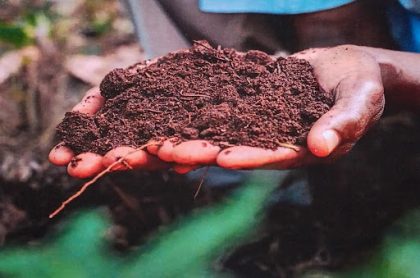
Composting is a controlled process that utilizes naturally occurring organisms to turn waste material into valuable organic fertilizer.
Why composting?
- Weed and pathogen sensitization (high temperature kills them)
- Balanced nutrients for plants
- Affordable as materials are available around farms.
The amount of compost to prepare depends on the following
- The crop to be plated: different crops require different amounts of nutrients.
- Fertility status of the farm: soils with low fertility require more compost, while fertile soils require less.
- Integration of compost with other amendments available for soil fertility improvement.
What to consider before preparation about compost location
- Close to composting materials source, like manure
- Under shade
- Avoid sharp gradients! Level such surfaces if necessary
- Avoid proximity to water bodies.
On-farm resources for composting
- Manure
- Cattle/poultry manure
- Domestic and municipal waste
- Use decaying matter/forest/thicket soil if you do not have access to the above

2. Green Materials
- Fresh clippings of grass
- Fresh twigs from live hedges, e.g. Lantana, Tithonia diversifolia, etc.

3. Dry matter
- Dry maize stalks, bean stovers
- Dry grass
- Dry tree leaves
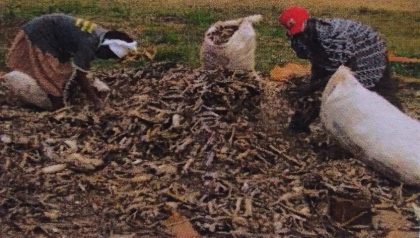
4. Miscellaneous inputs (not essential)
- Wood ash (do not overuse. A handful sprinkle suffices per layer), biochar, soil.
- Commercial inoculants

- Avoid: Dog, donkey and cat manure; eucalyptus and cassia tree leaves; plastic and other non-biodegradable material or medicine.
- Ratio: 4 parts manure: 2 parts dry matter: 1-part green matter. If you do not have the dry and/ or green matter, manure will still make good compost.
Procedure of compost heaping.
Start by dividing the respective materials into at least 3 portions (composting will hasten when you have more than 2 layers to stack)
- Materials should be chopped into small pieces to hasten the process; approximately the size of an index finger (5-10cm)
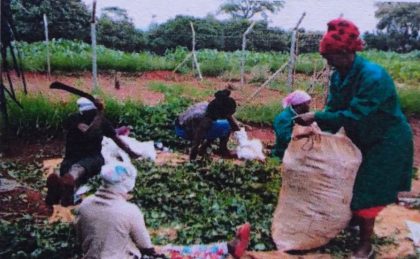
2. Spread a layer of large dry wastes (small tree branches/twigs, straw, small pebbles/stones, etc.) for aeration and moisten the surface.
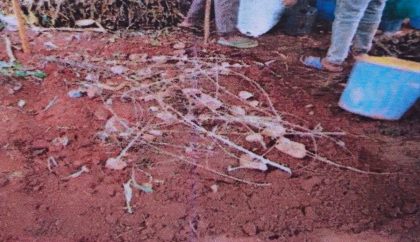
3. Add a dry matter layer and spread. Water the layer until the materials are adequately moistened.
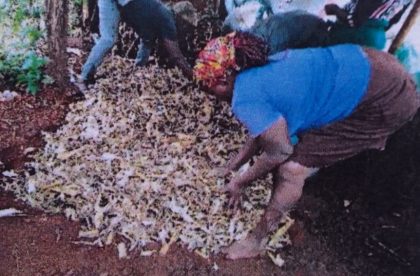
4. Add a layer of cattle manure and spread to about the length of your palm (1/2ft) & moisten.
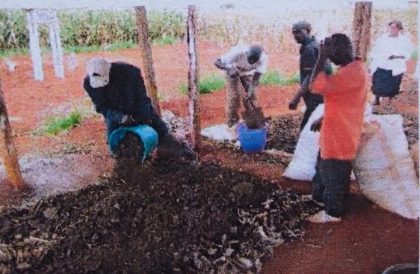
5. Add a layer of green materials.
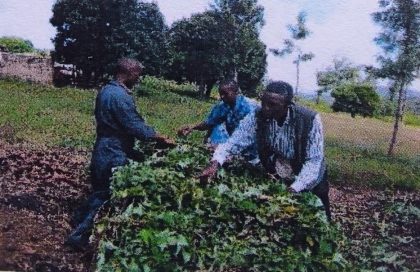
6. Sprinkle with a handful of wood ash/ biochar and soil or spray commercial supplements. Moisten the heap.

Repeat steps 3-6 until you exhaust the portions of materials that you prepared.
7. Irrigate the compost to saturation.
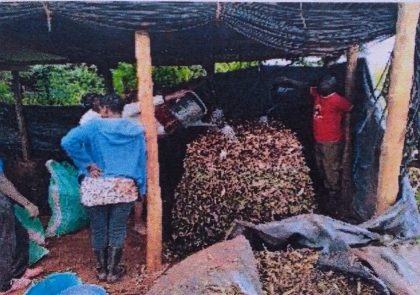
8. Diagonally insert a sharp, dry, pointed stick into the compost pile (thermostick)
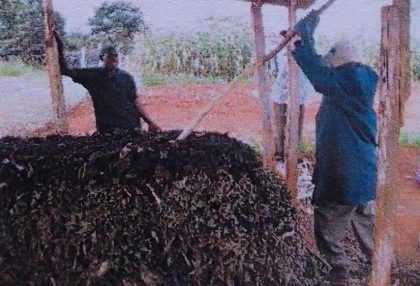
9. Cover the pile with soil and grass or old sacs to retain the moisture and the gases inside.

Heap size and turning guidelines
- Don’t heap more than 5 layers
- Instead, increase the length of the heap!
- For a quality compost, turning should be done at least once every 5 days for the first three weeks and thereafter, once per week until 2 months.
- After two months, compost can be left to cure without turning. Check moisture to ensure modest moisture levels.
Guidelines for use of thermostick
- Periodically remove the thermostick and check whether it’s dry or how hot it is
- Do this at least once every 3 days for the first 3 weeks and once weekly until 2 months.
- When the thermostick is covered with whitish materials, turn and water the compost.
How do I know my compost is ready?
Raw manure/freshly composted

- Unpleasant odour
- Has visible plant material
- Scorches plants if applied
- Composting materials can be seen and almost identified
- Compost heap temperatures are high
Not fully composted

- Dry matter is visible.
- Less foul odour but no earthen smell.
- The compost heap has episodes of sudden rise in temperature especially after turning.
- Intermediate temperatures- no too hot neither close to ambient.
Fully composted

- Earthy, dark, crumbly/soil like i.e. almost granular.
- Properly managed compost will be ready in two months.
- Earthen smell (smells like forest soil)
- The compost heap has temperatures close to environment.
- If you see remnants of dry matter and it is planting time, you can remove them from the manure before applying.
Vermicompost and worm tea production on-farm
Vermicompost and worm tea production on-farm
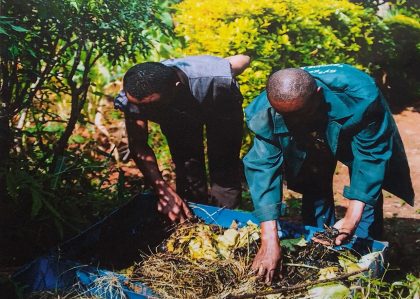
Vermicompost is a nutrient-rich manure that remains after earthworms feed on organic wastes.
Benefits
- Rich in nutrients like nitrogen, phosphorous and potassium.
- Promotes microorganisms that improve soils and reduce soil-borne diseases.
- Utilizes domestic and farm waste hence cheap and reduces organic waste.
- Improves water holding capacity.
- Improves soil aeration.
- Attracts deep burrowing earthworms already present in the soil.
- Enhances germination, plant growth and soil structure.
- Improves root growth and soil structure.
- It requires low capital investment and relatively simple technologies make it practical for small holder farmers.
- It is the fastest composting method.
Worm tea or vermicompost tea is a liquid fertilizer produced by drenching vermicompost in water.
Benefits
- Rich in crop nutrients like nitrogen, phosphorous and potassium.
- Enhance soil health
- Easily applied to plants as a foliar spray or soil drench.
Low-cost setup of a vermiculture unit
- The rearing area should be secure and elevated position, with moisture, aeration, food, and warm (not hot) temperature.
- Construct a structure using bricks or drums cut into two piece along the height.
- A bucket or waste bin can be used for small-scale production.
- A pit on the soil surface will work for vercompost but not worm tea.
- You can purchase worms from local suppliers or online sources.
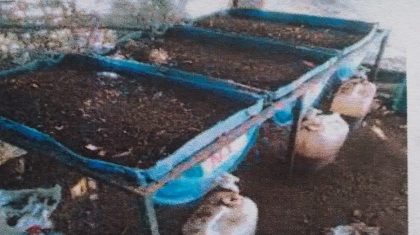

4 easy steps of establishing a vermiculture unit
- Add dry materials e.g. banana trash, maize stalks, coffee husks etc.
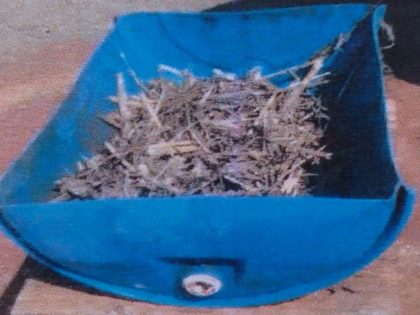
2. Add finer materials, e.g. cattle, sheep. Goat manure and composted poultry manure- too much chicken manure is discouraged.
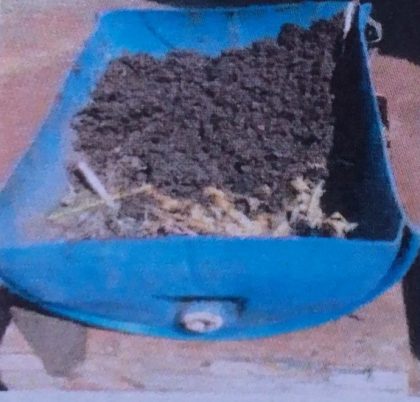
3. Add earthworms: place small handfuls of compost rich in earthworms (cluster) into “wells/holes” within the vermicompost trough. Fill up with vegetables/garden waste.

4. Cover the unit from direct sunlight by roofing or applying twigs/dry matter on the trough.
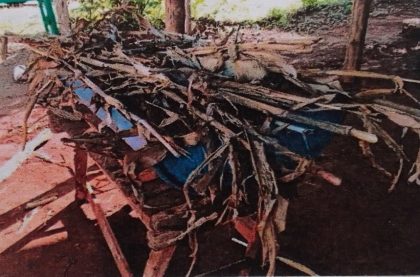
Feeding the worms
Regularly add fresh materials (at least once a fortnight) as additional layer.
Good | Avoid |
| × Too much meat, dairy, and oily foods |
| × Too much citrus (orange, lemon and lime peels) that can make the environment acidic |
| × Smelly veggies like onions and broccoli |
| × Too much salt is bad for worms |
Harvesting Vermicompost
- Move all the compost content to one side and put fresh material the other side.
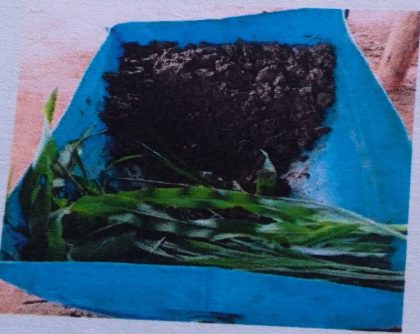
2. Cover the side with fresh materials, leave compost exposed to sunlight.
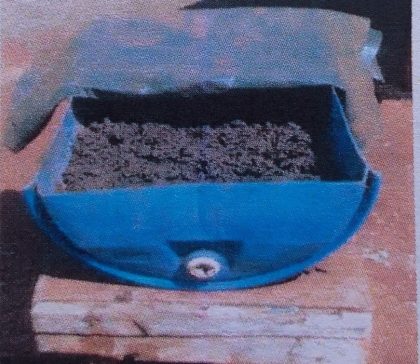
3. Empty the old manure (vermicompost) for use.
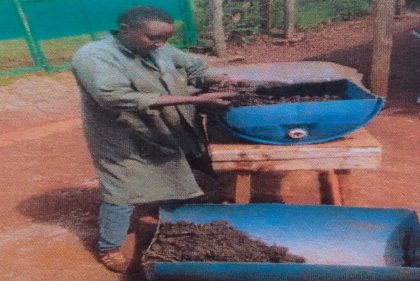
Harvesting the vermiculture juice or worm tea.
- Add slightly more water to the trough.

2. Incline one side after 1-3 days and add some more water.

3. After 1 week, open the cork and drain the liquid into a separate container.

4. Cork back and return the trough to the level position.

5. Dissolve the drained juice into 10-20 parts of clean water apply to your soils/crops.
Worms may also be sieved from old manure and fed to fish and poultry.
Homemade Liquid Fertilizers
HOMEMADE LIQUID FERTILIZERS.
What are homemade liquid fertilizers?
Liquid fertilizer is concentrated content made from weeds/ plant material that is organic and is used for top dressing.
Importance of Liquid Fertilizer.
- It can easily be made at home.
- It acts fast (faster than compost)
- You can apply it anytime, for example 5 to 6 weeks after planting.
- Depending on the plants used, liquid fertilizers also repel pests
- It is economical/ saves time
- Materials are locally available and can be easily accessed by the farmers
Plants used for Making Liquid Fertilizer
- Stinging Nettle (Urtica)
This plant provides a variety of nutrients and can be used as a powerful pesticide.

2. Tithonia
This plant is rich in Nitrogen and Phosphorus. Its stems and leaves rot very easily, realising all nitrogen into the soil.

3. Comfrey
It is normally grown on the farms as fodder crop especially for pigs and poultry. It is rich in potassium and provides vitamin B12 which stimulates root growth at transplanting.

HOW TO MAKE THE LIQUID FERTILIZER
- Collect enough fresh, green plant material (weeds, stinging nettle, tithonia, comfrey, borage, etc.) to fill a bucket. You can choose any size bucket, depending on the amounts of green materials you have.
- Use your panga or secateurs to chop all materials up, roughly into the size pf your hand. (For stinging nettle, you better wear gloves)
- Fill the bucket with the chopped-up material.

4. Fill the bucket with water until all the plant material is completely covered
5. Cover the bucket loosely so that mosquitoes can’t breed in it.
6. Use a big stick to stir your “brew” daily to incorporate oxygen. The more oxygen you can incorporate, the better.
7. Leave the “brew” for about 2 weeks, stirring daily.

8. The “brew” will start to bubble and smell. This is good, it means that the fermentation process is well under way. After about 2 weeks the bubbling will stop. The plant material would have dissolved and only the harder parts will remain as kind of a sludge. Remove them with the stick. The fertilizer should now have a dark green, opaque colour.


The finished product
9. Strain the liquid through a cloth (if you want to apply it with a sprayer) or a sieve (for application to the root area)

10. Store it in a closed container in a dark, cool place until you want to use it.
HOW TO APPLY THE LIQUID FERTILIZER
- Never use it undiluted. It is very strong and can chemically burn your crop. Always dilute 1 litre of liquid with 20 litres of water (1:10) for root application or 1 litre of liquid with 20litres of water for foliar application.
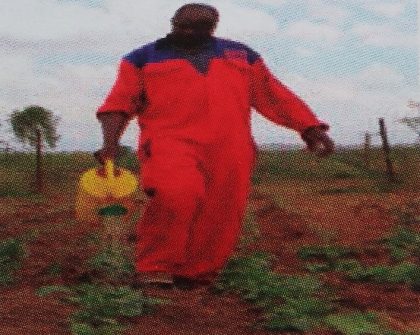
2. Apply it with a watering can to the root zone of each plant or use a knapsack sprayer to apply it as a foliar feed. No protection gear is needed.
3. Weekly applications are recommended.
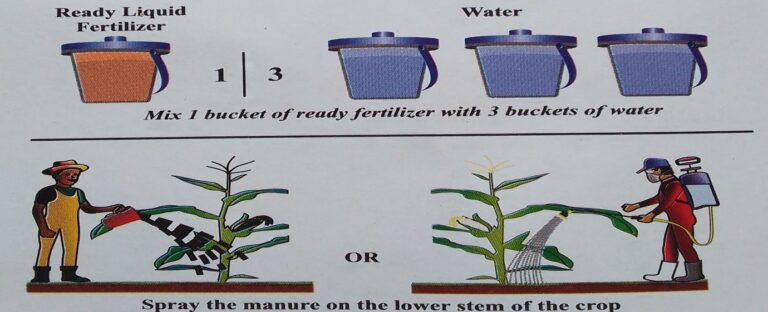
This simple and quick method provides you with a good and cheap source of fertilizers that can be easily stored and safely applied any time.
NOTE: For making the best liquid fertilizer, the plants should be dark green and about one meter tall. Ideally, you mix different types of these plants. After flowering, the plant is no longer high in nitrogen as most of the nitrogen is used for the flowers.
Preparation of home-made plant extract for pest management
Preparation of home-made plant extract for pest management

The use of plant extracts in the management of cabbage (Brassicas) major parts.
- Ninety percent (90%) of smallholder farmers in Kenya grow vegetables like cabbage and kales.
- The major pest of brassica includes: Diamondback moth, Cabbage aphid.
- The filtrate can be used to spray cabbage against various pests, such as the diamond moth and cabbage aphid.

Diamondback moth adult

Damage caused by moth in the larval stage

Cabbage aphid
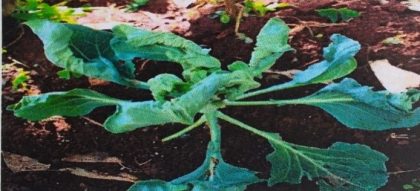
Damage caused by the adult and nymph stages
Home-made botanicals (plant extracts) are liquid or powder preparations made from plant parts such as fruits, seeds, leaves, bulbs, or roots from the management of pests and diseases.
Why choose plants extract?
- Readily available within farmers’ ecosystems and contain phytochemicals with pesticide activities.
- Safer and less toxic to humans and beneficial insects.
- Environmentally friendly and break down rapidly, reducing soil pollution while preserving soil microbes, fauna, and water quality.
- Contain compounds that allow them to be integrated with other pests’ management strategies with or without minimal impact om beneficial organisms.
- Promote the ecological balance of macro and microorganisms at the farm level.

Resources needed for on-farm production of plant extracts
- Two portions of young fresh plant leaves/shoots of lantana and Mexican marigold each
- One portion of garlic and chili each
- Half portion of neem powder
- Water, clean buckets, knife, chopping surface and sieving material
Procedure of preparing the plant extract
- Sort and clean plant materials. Remove the parts of the plant material as described in the next step.

2. Take two portions of clean, freshly harvested Lantana leaves, cut the leaves into small pieces- put in a clean bucket

3. Take two portions of clean fresh harvested marigold leaves, cut them into small pieces- add them in the bucket.

4. Take one portion of garlic bulbs, peel and cut them into small pieces or crush in into fine paste or a clean pieced of wood against a hard clean surface.

5. Take one portion of fresh chili, cut, pound or crush them into small pieces/a fine paste using the same tool as with garlic.

6. Use half portion of neemcake powder.

7. Mix all the materials in a clean bucket and add 15 litres of water.
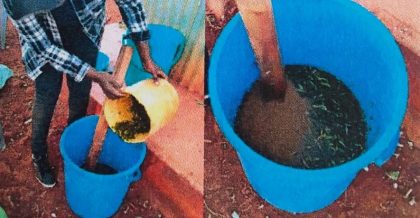
8. Cover the bucket with a lid and leave it for 24 Hours. Afterwards sieve the filtrates using a fine cloth.

9. Add about a drop of liquid soap to the mixture and stir.
Points to note when using the plant extract
- Application: Apply plant extract using sprayers, ensuring thorough coverage of foliage, stem and fruits.
- When to apply: The plant extract should be applied in the evening to ensure maximum activity against the pest.
- Frequency of application is determined after assessing the pest pressure or at the first sign of pest infestation. Application can be repeated based on the crop pest pressure and growth stages of the crop
- Shelf life of the plant extract: The activity of the plant extract deteriorates rapidly, with a maximum storage period of 3 days.
- Mode of action: The plant extract acts against the pest through contact, repellence and deterrence on feeding and egg-laying of the insect pest
- Integration of the plant extraction with other IPM strategies: Plant extracts can be incorporated into other integrated pest management (IPM) strategies, such as biological controls and cultural practices for most effective crop pest control
Castor Plant Bio-Pesticide
CASTOR PLANT BIO-PESTICIDE

SCIENTICIF NAME: PICINUS COMMUNIS
KISWAHILI: MBARIKA
CASTOR PLANT
A fast growing perennial, evergreen, soft woody shrub or small tree up to 7-10m high. Stem and branches have conspicuous nodes and ring like scars and glands often present at nodes.

USES
Bio-pesticide: acts as a natural deterrent against aphids, whiteflies, spider mites, and other soft-bodied insects on vegetables and fruits
Fungal control: against powdery mildew and black spots on vegetables and legumes.
SHELF-LIFE
Use within 10 days from the date of preparation.
PREPARATION
- Collect fresh castor plant leaves and seeds. Be sure to wear gloves and handle with care, as all parts of the plant are toxic if ingested.
- Chop the leaves and seeds into small pieces to increase the surface area of extraction
- Place the chopped leaves and seeds into a large pot of water. Use a ratio of approximately 1-part plant material to 10 parts water.
- Bring the mixture to a boil and then reduce the heat to let it simmer for about 30-45 minutes. This allows the beneficial compounds to be extracted into the water.
- Remove the pot from heat and allow the mixture to cool completely.
- Strain the mixture through a fine mesh sieve or cheesecloth to remove the plant solids, leaving behind the castor plant tea.
- Add a few drops of liquid soap to the tea to act as a surfactant. This helps the foliar spray stick to the plant leaves more effectively.

FREQUENCY OF APPLICATION.
Apply the castor plant tea once every two weeks or as needed, depending on the severity of pest infestation or plant health issues.
SAFETY PRECAUTION
- Always wear gloves and protective clothing when handling castor plants or tea, as they are toxic of ingested or in contact with wounds.
- Store unused castor tea in a labelled container, away from children and pests.
- Dispose plant residues and leftover tea properly to avoid water contamination.
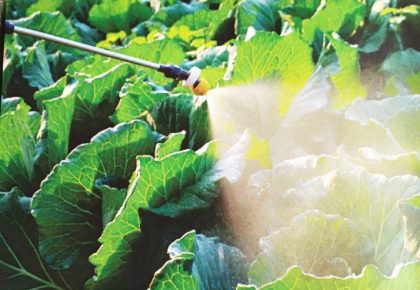
CASTOR AS OLANT HEALTH ENHANCER
- Castor plant tea contains essential nutrients and organic compounds that can enrich soil, improving its fertility and structure. This enhances the nutrient uptake by plants, promoting stronger growth.
- The organic matter in the tea supports beneficial microbial activity in the soil, which is crucial for nutrient cycling and soil health.
- The tea contains natural growth stimulants that can enhance plant vigor. These compounds promote root development, leading to healthier and more resilient plants.
- Regular application of castor plant tea can increase plants’ resistance to environmental stressors, such as, drought, extreme temperatures, and pest pressure.
Comfrey Bio-Pesticide
COMFREY BIO-PESTICIDE

SCIENTICIF NAME: SYMPHYTUM OFFICINALE
KISWAHILI: MWANGANI
COMFREY
The plant is erect with plenty leaves which are hairy all over. It has flowers which are either creamy yellow or purple.

USES
As a Strengthener
- The leaves are rich in nutrients and can be used as mulch or in composting.
- Comfrey tea can also be used as liquid fertilizer as it is rich in nutrients.
- Comfrey solution can be used to prevent powdery mildew.
PREPARATION
- Pick a handful of leaves and place in a container with enough water to cover the leaves.
- Let it soak for 2 weeks in cool weather or 2 weeks in hot weather.
- Squeeze the leaves to extract as much juice as possible.


ACTIVITY INGREDIENTS
Contain N 1.8% and K 5.3%
APPLICATION
Strain and dilute 100mls of the solution with 4 litres of water.
Can be used as foliar feed or soil drench
TARGET CROPS
- Vegetables
SAFETY PRECAUTIONS
- The mixture should not be ingested by humans
- Keep away from children
TARGET PESTS
- Wasps
- Spiders
- Lacewings
Coriander Bio-Pesticide
CORIANDER BIO-PESTICIDE

SCIENTIFIC NAME: CORIANDUM SATIVUM
KISWAHILI: DHANIA
CORIANDER
Is an erect annual herb in the family apiaceae. Leaves are variable in shape, broadly lobed at the base of the plant, and slender and feathery higher on the flowering stems.
It is soft, hairless plant. Coriander propagated directly from seeds.
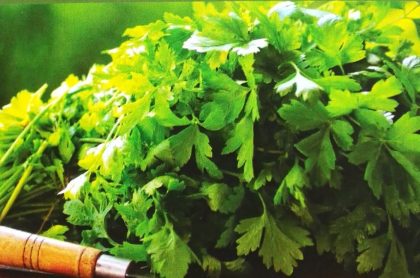
USES
Coriander emits a strong, distinctive odor that is effective in repelling a variety of pests and insects, including:
- Potato Weevils: Deters these pests, which are known for damaging potato crops.
- Aphids: Helps protect a range of vegetables from these sap-sucking insects.
- Spider Mites: Reduces infestation that can affect the health and yield of vegetables.
ESTABLISHMENT
Intercropping:
Coriander can be planted alongside the main crops, such a s African Leafy Vegetables (ALVs), tomatoes, kales, and broccoli. This practice not only helps in pest control but also promotes biodiversity, improving the resilience of the farming system.
Borderline Crop:
Planting coriander around the edges of fields creates a natural barrier that helps keep pests away from the primary crops
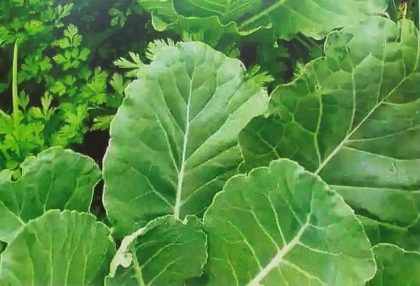
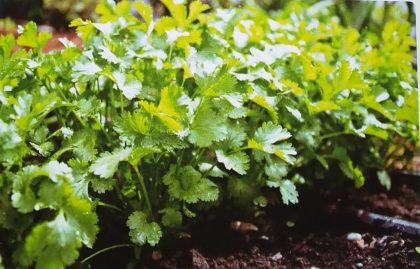
ACTIVE INGREDIENTS
Linalool, terpenene, camphor, geranyl, acetate.
CORIANDER VARIETIES
- Cilantro– has flat toothed leaves also known as spiny coriander.
- Seed coriander– this is grown for its seeds.
- Leaf Ciliantro– resembles parsley and has a strong and sharp smell.
- Vietnamese coriander– has narrow smooth-edged and darker leaves.
SHELF-LIFE
Use within 10 days from the date of preparation.
STORAGE
Fresh harvested coriander can be dipped in fresh water or refrigerated to prevent wilting.
Keep away from children
Use an airtight glass or plastic container.
Label your containers with the date of preparation to keep track of freshness.
Cow Urine Bio-Pesticide
COW URINE BIOPESTICIDE
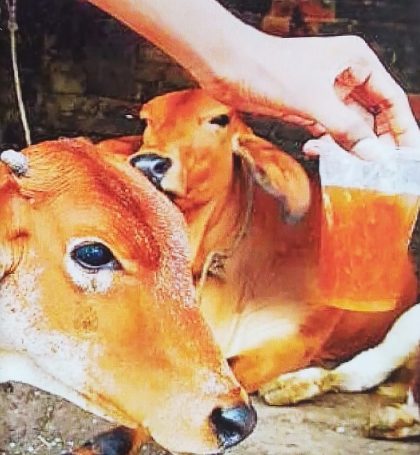
KISWAHILI: MKOJO WA NGOMBE
COMMON NAME: GOMUTRA (Derived from Hundi)
COW URINE
Cow urine is a liquid by product of metabolism. It is golden yellow in colour with a pungent smell.
The average cow of 300kgs produces about 10-15 litres of urine which contains 95% Water, 2.5% Urea, and a mix of minerals. Salts, hormones and enzymes which accounts 2.5%
Contains bioactive components such as, amino acids, volatile substances and chemical components such as ammonia, nitrogen, Magnesium, potassium, creatinine and sulphates. Has a PH between 7.27 to 8.71.
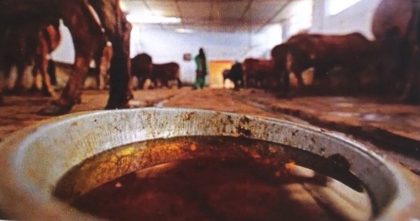
SHELF-LIFE
Use within 10 days from the date of preparation
USES
- Preparation of Vermicompost.
- Bio fertilizer. (Urine and Farm Yard Manure).
- Increase soil ph, EC values, and nutrients and dissolve organic carbon.
- Natural insecticide against sap sucking insects in eggplant, black night shade and tomatoes (whiteflies and aphids) (Patel et al.,2019)
- In combination with garlic (Allium sativum) bulb powder, neem, (Azadirachta indica), oil, Annona squamosal seed powder, Ferula asafoetida root latex in sunlight is more effective against snails (Lymnea acuminate)
PREPARATION
Take 50 ml cow urine

Add 500ml of water

Mix together in a Jerrican

Put in a sprayer and apply on your vegetables

ACTIVE INGREDIENTS
Halogenated phenols- antifungal, Manganese and carbolic acid-antibacterial and pesticidal, 2-phenyl phenols-antiviral and antimicrobial, Aurum oxide-antibiotic.
RATE OF APPLICATION
200L of the dilution/Acre (Agritech.tnau.ac.in)
PRECAUTION
- Observe the dilution ratio to avoid scotching of crops
- Use protective gears
- Keep away from children
ANTIDOTE
If accidentally ingested;
- Drink a lot of water
- Use activated charcoal.

FREQUENCY OF APPLICATION
Pre flowering phase: once in 15 days, two sprays depending upon duration of crops
Flowering and pod setting stage: Once in 10 days
Fruit/ pod maturation stage: once during pod maturation.
Garlic Bio-Pesticide
GARLIC BIO-PESTICIDE

SCIENTIFIC NAME: ALLIUM SATIVUM
KISWAHILI: KITUNGUU SAUMU
GARLIC
Garlic is a species of bulbous flowering plant in the genus Allium.
Its close relatives include the onion, shallot, leek, chive, Welsh onion and Chinese onion.
USES
It has anti-feedant-allicin (insect stop feeding), bacterial, fungicidal, insecticidal, nematicidal and repellent properties (Aphids, Beetles, Armyworms, Caterpillars, Mites, Mosquitoes, Cutworms, Flies).
Garlic is effective against a wide range of diseases-causing pathogens (fruit rots, rusts, blights, anthracnose) and insects (African bollworm, downy mildew, African armyworms, onion thrips, root knot nematodes, rice bugs) at different stages in their life cycle.
Intercropped with crops to repel insects
PREPARATION
- Peel the garlic cloves and puree the cloves along with the oil and water.
- Allow to sit overnight and then strain the mixture.
- Add soap and mix thoroughly.
- Pour into a spray bottle and use on pest infected plants.


SHELF-LIFE
Use within 10 days from the date of preparation.
ACTIVE INGREDIENTS
Organosulfur compounds (diallyl sulfide, dially disulphide, dials trisulfide)
RATE OF APPLICATION
2.3 to 3.3 litres per hectare.
Applied after the crop has emerged up to the 4 true leaf stage.
PRECAUTION
Can kill beneficial insects hence use with caution
Not recommended for aphid control as it kills the natural enemies of aphids.
FREQUENCY OF APPLICATION
Pre flowering phase: once in 15 days, two sprays depending upon duration of crops
Lowering and pad setting stage: once in 10 days
Fruit/pod stage: once during pod maturation.
Ginger Bio-Pesticide
GINGER BIO-PESTICIDE

SCIENTIFIC NAME: ZINGBER OFFICINALE
KISWAHILI: TANGAWIZI
GINGER
Ginger is a flowering plant whose rhizome (Ginger root or ginger), herbaceous is used as a spice, flavouring food and medicine.
The leafy stems grow to about I meter in height.
The leaves are 15-30cm long, elongate, alternate in 2 vertical rows and raise from sheaths enwrapping the stem.
USES
- Killer: Bio pesticide for pests such as ants.
- Strengthener: Improves plant health (NPK element present)
TARGET PESTS
Sorghum aphis

Okra fleas beetles

Cabbage looper

Cowpea bruchid

GINGER PROPAGATION
Ginger is propagated by planting rootstalk cutting.
Harvesting done by lifting the rhizomes from the soil.
Ginger has a pungent smell due to 1-3% of volatile oils such as sesquiterpene, zingerone, kaempferol and zingiberene.
Numerous reports have been found supporting that crude extract of ginger has insecticidal properties.
PREPARATION
- Crush 100g of ginger.

i. 2. Add 500ml of water
3. Strain to get the liquid

4. Put in a sprayer and apply on your crop as foliar.
AVTIVE INGREDIENTS
There are about 400 different components present in ginger. Chemical component examination of ginger rhizomes reveals that the primary constituents include carbohydrates (50%-70), lipids (3%-8%), as well as phenolic and terpene constituents.
The primary phenolic constituents in fresh ginger primarily consists pf gingerols, paradols and shogaols. Ginger are most prominent in fresh ginger.
However, shogaols are found in trace amounts.
PRECAUTION
Ginger is possibly safe however, it might cause skin irritation for some people.
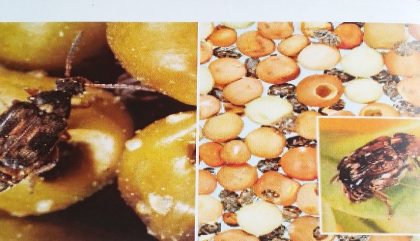
TARGET CROPS
- SORGHUM
- CABBAGE
- OKRA
- COW PEAS
Hot Pepper Bio-Pesticide
HOT PEPPER BIO-PESTICIDE
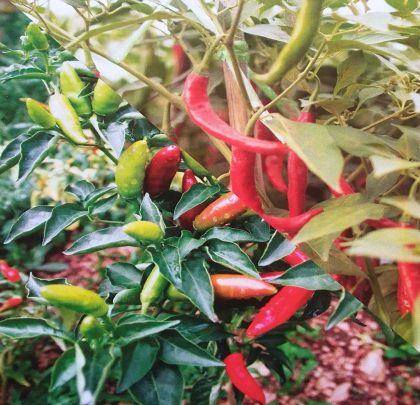
SCIENTIFIC NAME: CAPSICUM ANNUUM
KISWAHILI: PILIPILI
HOT PEPPER
An ancient Latin-American crop with outstanding bioactive compounds and nutraceutical potential.
Chili peppers are varieties of the berry fruit of plants from the genus Capsicum, which are members of the nightshade family Solanaceae, cultivated for their pungency.
Chili peppers are widely used in many cuisines as a spice to add “heat” to dish. Chili peppers exhibit a range of heat and flavours.
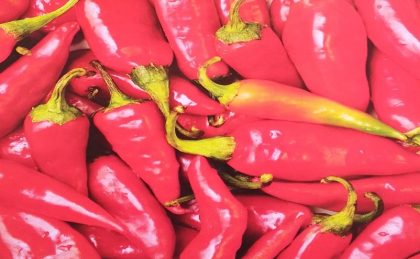
ACTIVE INGREDIENTS
- Capsaicin
PREPARATION
- Chop 500g of chili and mix with 5 litres water.
- Leave for 24 hours or boil for 20 minutes.
- Sieve the extract and add an additional 5 litres of water and equal amount of soapy water (5 litres) to make 10 litres.



USES
As a killer: Concoctions integrated with chili are also used to control pets such as ants, termites, aphids, fall armyworm and African army worms in spider plant, black night shade, Jute mallow, kales, cow peas, legumes and cereals.
As a trap: The plant is planted at the border to attract pests such as bell pepper maggots and aphids from vegetables.
As repellent: It produces Capsaicin which is an anti-feedant to pests thus repelling the pests.
TARGET CROPS
- Tomatoes
- Black night shade
- Sweet potatoes
- Spider plant
- Bananas
- Fruit trees
PRECAUTION
- Can cause skin irritation/skin burns and adverse reaction to people with allergies and asthma.
- Avoid spraying on windy weather.
- Use of masks, overall, goggles, gum boots and gloves, should be observed when applying to avoid contact and inhalation.
ANTIDOTE
- Wash with clean water and soap.
SHELF LIFE
- Use the mixture within 2-3 weeks
Mexican Marigold Bio-Pesticide
MEXICAN MARIGOLD BIO-PESTICIDE
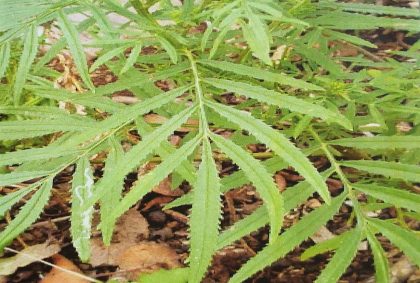
SCIENTICIC NAME: TAGETES MINUTA
KISWAHILI: MKENGEWA
MEXICAN MARIGOLD
It is an erect woody annual herb usually 0.5m-2m tall with strongly odorous foliage.
Its tapped roots are surrounded by fibrous roots which form mycorrhizal associations.

PREPARATION
- Mixture if the leaves is chopped and crushed.
- Then mixed with water in the ratio of 1kg: 3litres
- Mixture is left to soak for 1-2 days in cold water or 2-3 hours in warm water.
USES
As a repellent
It is planted randomly inside the main crop farm and/ or along the edges in combination with worm wood.
It produces a chocking scent which repels pests attracted to the worm wood.
As an attractant
- The scent also attracts beneficial insects such as lady birds and parasitic wasps which in turn feeds on insect pests on green leafy vegetables and those attracted on worm wood.
- Roots produce exudate the repels nematodes.
As a killer
A concoction is prepared by combining it with other additives such as:
- Blackjack
- Tithonia
- Hot pepper
- Aloe Vera
SHELF LIFE
2-3 days, while still fresh.

ACTIVE INGREDIENTS
Pentacosane (22.01%), Gammasitosterol (15.80%) and Pentatriacontane (11.95%)
APPLICATION
- Filter/sieve and dilute with water in ratioof1:2
- Spray directly to the leaves to control pests.
TARGET CROPS
- Cowpeas
- Black nightshade
- Kales
- Spider Plant
- Jute mallow
- Legumes
- Cereals
- Banana
PRECAUTION
Avoid overwatering which may cause root rot.
Target pests
- Caterpillars
- Aphids
- White flies
- Maggots
- Ants
- Termites
Pawpaw Bio-Pesticide
PAWPAW BIO-PESTICIDE
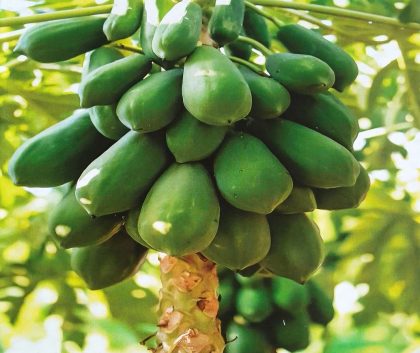
SCIENTIFIC NAME: CARICA PAPAYA
KISWAHILI: PAPAYA
PAWPAW
Papaya is a tropical fruit having commercial importance because of its high nutritive and medicinal value.
Its leaves contain nitrogen, phosphorus and potassium that can be used in making conventional compost as a green matter.
Best used at vegetative stage.

USES
- Acts as a strengthener and also killer.
- Pawpaw leaves contains an active ingredient called papain that works actively as a stomach poison to pests such as aphids, caterpillars and worms.
- The use of papaya leaves as organic fertilizer can enhance soil quality, promote growth of leafy vegetables.
- Pawpaw leaves can also be used as organic mulch.
PREPARATION
Pawpaw leaf extract is prepared using the following procedure:
- Take 5kgs of pawpaw leaves, wash and chop for faster results
- Mix 20 litres of water
- Put the mixture in a jerry can/bucket and let it stand for two days
- Stir twice a day, strain and sieve using a fine cloth.
- Spray to affected crops without further dilution.

SHELF-LIFE
Utilize within 5 days.
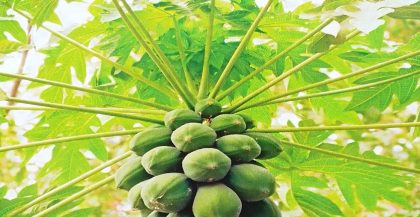
ACTIVE INGREDIENT
“papain”
APPLICATION
Spray to affected crops without further dilution.
The mixture can be applied on one quarter of an acre of land.
TARGET PESTS
- Aphids
- Caterpillars
- Worms
TARGET CROPS
- Black night shade
- Amaranth
- Sukuma Wiki
- Spider plant
- Tomatoes
- Cowpeas

SAFETY PRECAUTION
- Post-harvest interval is one day.
- The mixture should not be ingested by humans.
- Wear protective gears.
- Keep away from children.
Sesame Bio-Pesticide
SESAME BIO-PESTICIDE
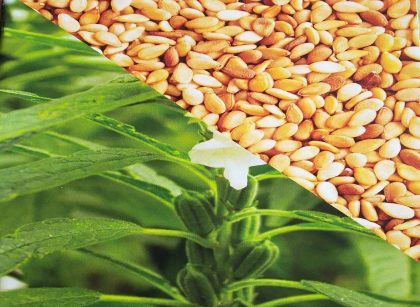
SCIENTIFIC NAME: SESAME INDICUM
KISWAHILI: SIM SIM
SESAME
This is an herbaceous annual plant cultivated for its edible protein rich seed and oil. Sesame seeds are rich in protein, fats, minerals vitamins and dietary fibre.

USES
- As a plant strengthener
- As a repellent
PREPARATION
- Chop sesame talk or use the sesame chaff to incorporate in the soil before planting.
- Apply the stalk or the chaff as mulch.
- Intercrop sesame and tomatoes two weeks after transplanting at an interval of 2 tomato lines and 1 sesame line to attract mirid which feed on whiteflies and tuta absoluta to reduce their population
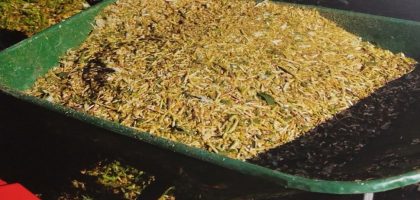

ACTIVE INGREDIENTS
Sesame lignans: Sesamin, sesamolin. sesaminol and sesamolinil)
OTHER USES
Sesame stalks can be compressed into briquettes, which can be used as an alternative fuel.
Briquettes have a high calorific value and produce little smoke and emissions.
However, the quality of the briquettes can be affected by the ash and fixed carbon content.
TARGET CROPS
- Tomatoes
- Black night shade
- Sweet potatoes
- Spider plant
- Bananas
Fruit trees.SHELF-LIFE
Utilize within 5 days.
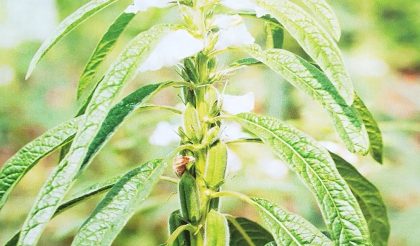
BENEFITS
- Sesame stalks are made up of long chain polymers like cellulose and fibre.
- They are generally considered safe as a mulch, and no harmful effects have been reported in humans or livestock.
TARGET PESTS
- Nematodes
- White flies
- Tuta absoluta
